Des Moines class cruisers (1947)
 USA (1945-58)
USA (1945-58)
USS Des Moines, Newport News, Salem. Dallas and 8 more cancelled Dec. 1945
The Des Moines-class were the last planned conventional heavy cruisers of the U.S. Navy heavy, designed as successors to the Baltimore, stretched and improved in every way. Laid down in 1945, only three on the twelve ships planned were commissioned in 1948 and 1949, the rest being cancelled between August 1945 and June 1946 (Dallas). The very last all-gun heavy cruisers by their size they were close to the massive Alaska-class. Their semi-automated 8-inches guns were revolutionary, and they are now regarded as vastly superior to the same generation Worcesters. Two were decommissioned by 1961 but Newport News (CA-148) managed to serve until 1975, now a museum ship in Quincy, Massachusetts. They served in Korea and Vietnam. #ww2 #coldwar #usnavy #salem #cruiser
The last US heavy cruisers
A precedent: The Oregon City class
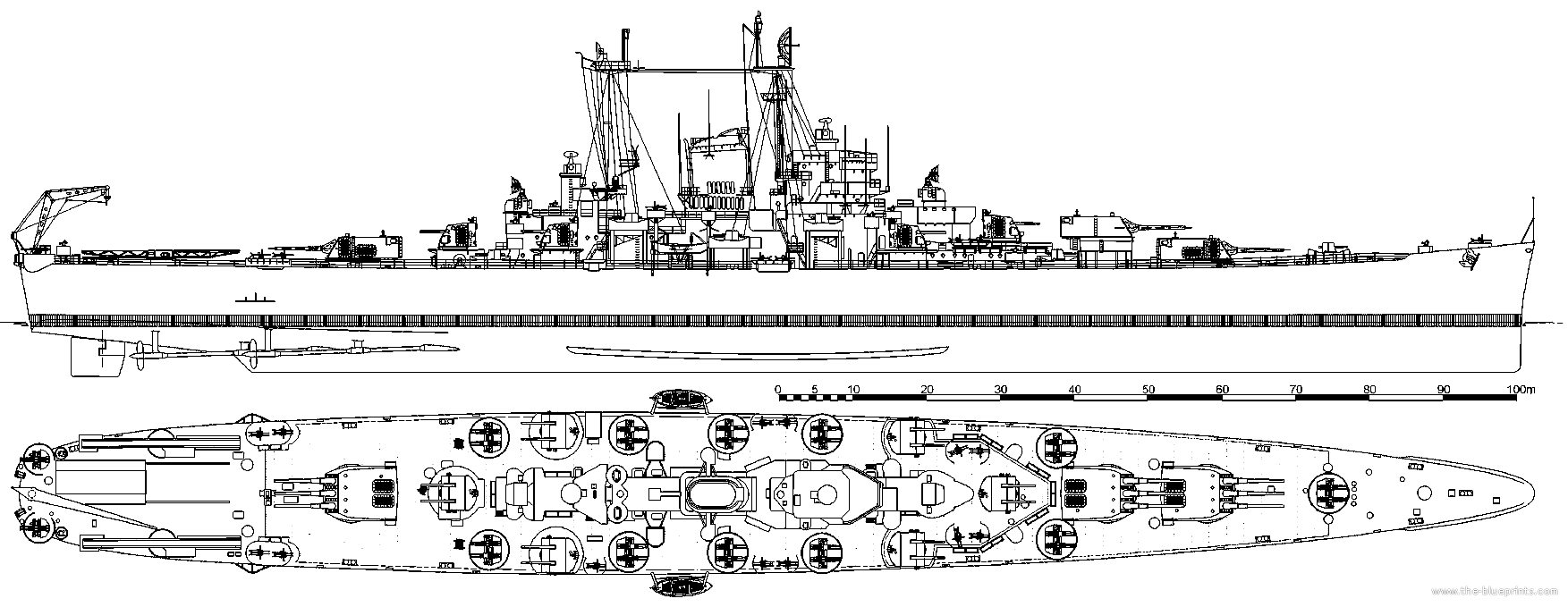
The previous Baltimore class design went back to 1940, when it was clear that with the war in Europe, all limitations went by the windows. Thus, they were created with the largest, optimal size to perform the best balance between armament, protection, speed, range and stability, and with extra room for AA and future upgrades. However the USN never has been satisfied with these cruiser’s main artillery, the 8-in/55 Mark 15. It was estimated too slow. In 1944 it was realized also their AA placement and arc of fire was not optimal, especially with the growing threat of Kamikaze. Thus a modified version was created, called the Oregon City class.
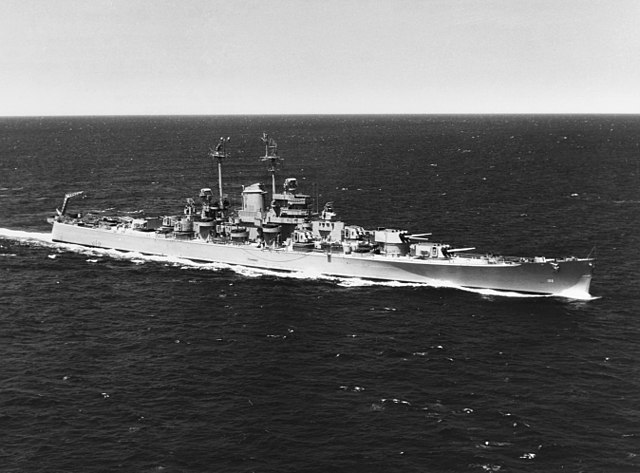
No change were made to the guns, although a brand new Mark 16 was worked out, which this time used a brand new semi-automated system to double the rate of fire. It was not ready when the four Oregon City were completed, too late to take part in WW2: USS Oregon City (CA-122) was commissioned on 16 February 1946, USS Albany (CA-123) on 15 June 1946, Rochester (CA-124) on 20 December 1946 and Northampton (CA-125) on 7 March 1953 after being converted to a command ship during construction. The remainder, USS Cambridge, Bridgeport, Kansas City, Tulsa, Norfolk and Scranton (CA-126 to 138) were cancelled on 12 August 1945 and scrapped on slip while budgets and materials were redirected to the more promising CA-134 programme (numeration between the Oregon City class ships).
The “Rapid Fire Cruisers” development (1943-45)
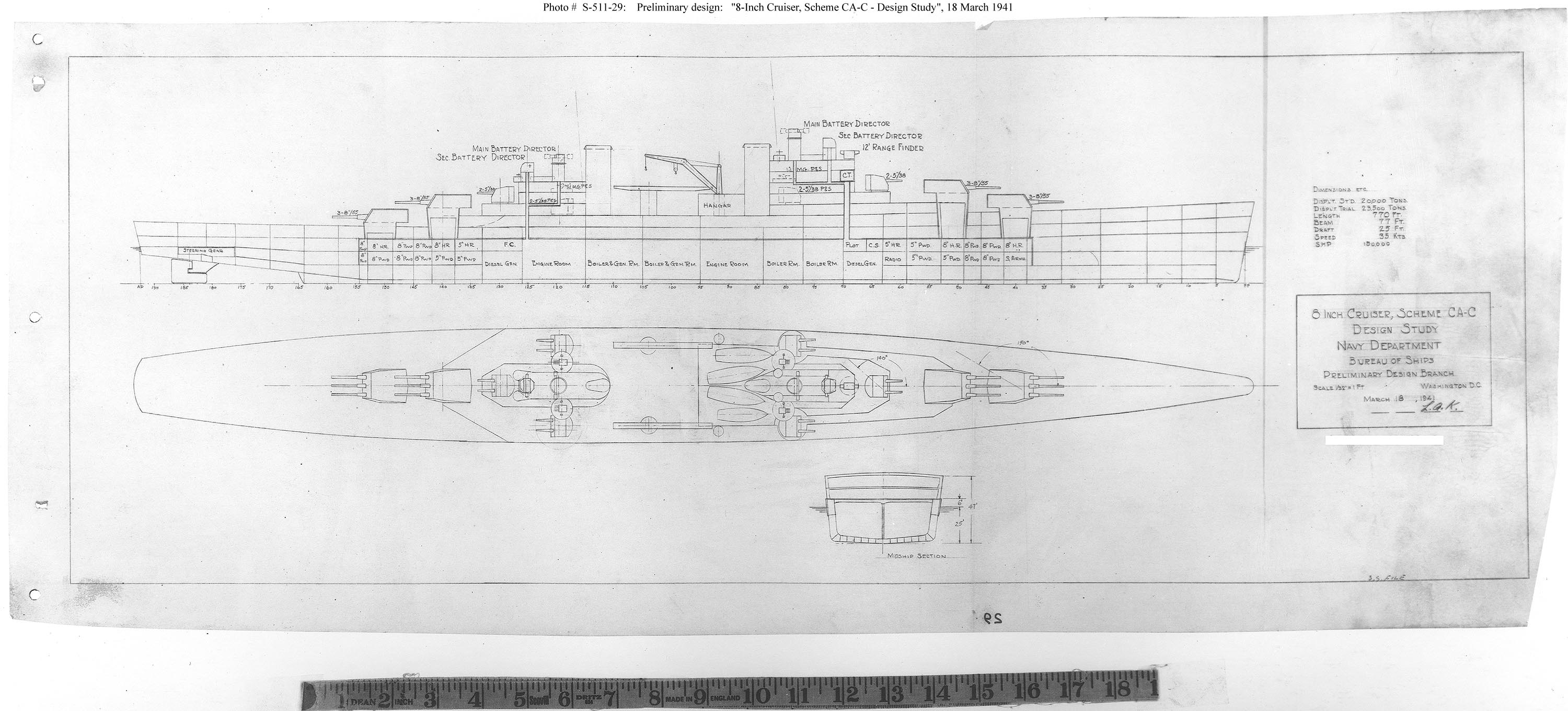
The early genesis of the CA-134 programme can be traced back to 1941, when the Baltimore class design already had been approved. Some in the admiralty board worried about possible IJN heavy cruisers with more firepower and asked the Bureau of Ships about a possible design upgrade to four triple 8-in turrets instead of three. The result was a stretched up Baltimore with superfiring main artillery fore and aft, and central catapults notably to clear the arc aft. This design study CA-C date of March 1941 was rated as a 20,000 tonnes standard (twice the Washington treaty limit !) and retrospectively the location of the catapults robbed the longer superstructures of any useful additional AA protection, which was the same as the Baltimore with just six twin 5-in/38 turrets. It was not hard to point out the limitations of the design. The four twin turret cruiser was eventually a way also to compensate by number of guns, the lackluster rate of fire of the existing Mark 15 guns. However things were rapidly moving in the ordnance department.
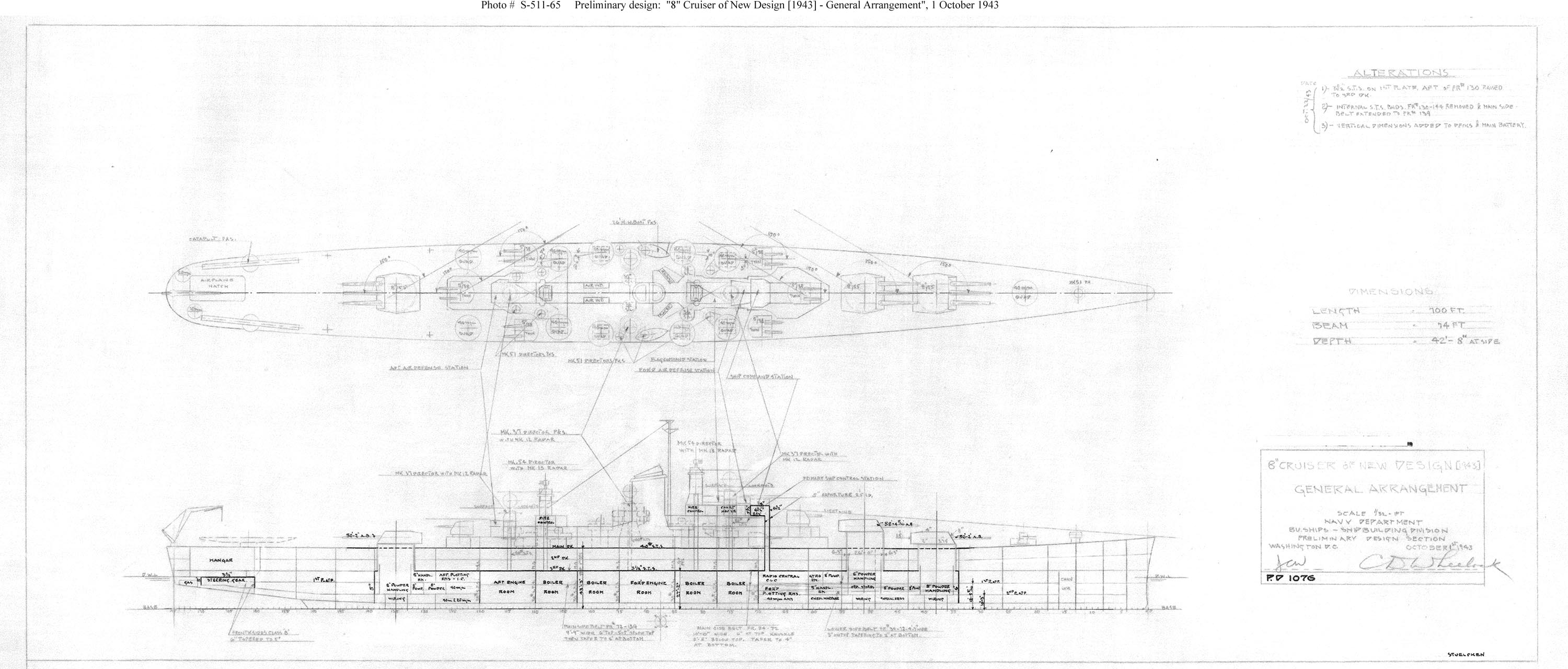
In 1942 indeed, the Ordnance gave these venerable 8-in/55 going back to the early 1930s at least a better shell, as better cradled and in-turret dstribution by having these individually sleeved and mounted further apart for better shell dispersion characteristics. The shell-handling equipment of the Baltimore/Oregon was revamped to operate also the new “super-heavy” 335 lbs. (152 kg) AP projectiles versus interwar cruiser’s 260 lbs. (118 kg) AP shells.
Still, these guns were only capable of 3-4 rounds per minute (the Cleveland’s 6-in/47 were capable of 12 rounds per minute for the Mark 16DP), which was three times slower. The Ordnance department was pressed regularly to come up with a faster design, and the process started in early 1943 on a new model using separate rather than bag ammunition, and automatic shell handling and loading. The complexity of it all, which mirrored similar developments for a new 6-in gun (later adopted for the Worcesters).
On paper, the new gun promised a three times greater fire rate, which received an enthiusiastic greenlight by the Board. But the new loading mecanisms were also estimated larger, so the guns would be pushed even further apart, resulting in an even large turret, and thus, larger ring mount, despite the will of the board to have Baltimore ships upgraded to the new turret as soon as possible.
We will come back on these guns when tacking the armament in detail.
So the admiralty was aware that the new turrets, which were were estimated by the ordnance to be heavier and larger, would need an equally larger cruiser to fit in. A simple upgrade of a Baltimore class hull was no longer sufficient. This was confirmed by Bureau of Ships initial studies in mid-1943. For the AA armament, it was clear in late 1943 when discussions went further, that a better and more optimized AA was also preferrable, less to face Kamikazes as most were now conscious that the war could end before these ships could be completed, but the planned upcoming jets in 1945.
In October 1943 BuShips submitted a proposal S511-65 preliminary design 8″ cruiser “of new design” which sported three triple turrets as for the Baltimore, but a somewhat more complact superstructure, truncating of exhausts in one funnel, to optimize the AA arc of fire. So in short, a streched Oregon city class which had no precised tonnage but a length of 700 feet (213 meters) of 74 ft in beam (22 meters). At that time, the AA armament was still classic, with the usual six twin 5-in/38 placed in strategic lozenge formation, and eleven quad 40 mm AA Bofors mounts. 20 mm mounts were likely twin ones, with only a few shown. They were supposed to be later shoehorn on any space available. The guns were controlled by the same Mark 37 and 54 gun directors, radar assisted.
If approved at that point, these ships could have been launched in mid-1944 and enter service in the dying days of WW2. However news from the ordnance were not optimistic. That early in the design of the new 8-inches guns, nothing was assured about the delay of deliverance; The navy could be facing the prospect of having a whole serie of brand new cruisers without armament for months and perhaps a year. In times of war this was a frightening prospect. Thus, design discussion on the “Cruiser of New Design” went on in November.
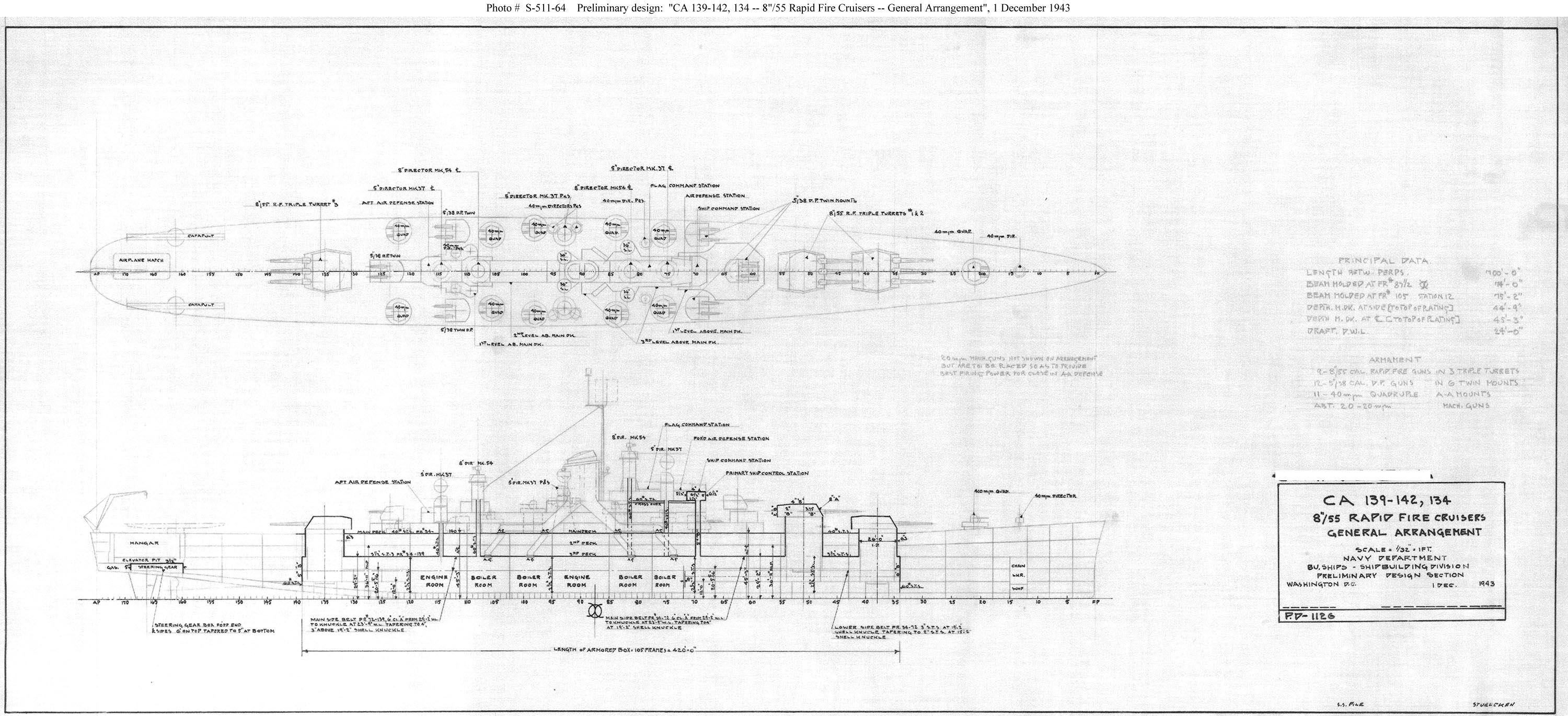
In December, it was decided to wait for the completion of the new “rapid fire” 8″ gun promised by the ordnance and thus, the design was revised as the “rapid fire cruiser”. There were no major change, the initial three trip configuration was kept, but maturation of the design process led to create an even more compact, centralized superstructure to optimize further the arc of fire and work out a definitive protection scheme in light of everything that has been put forward and reported previously. The funnel was pushed further back, and the now unique mainmast strenghtened for future radar platform updtates. Wiring was now connected to the new fire control support towers.
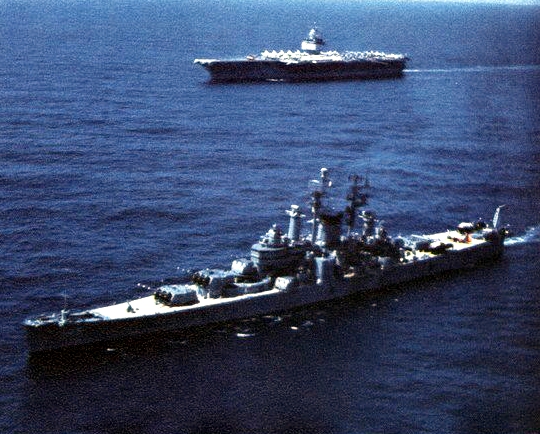
As stated in the scheme, if the 40 mm mounts were still shown (still twelve dual purpose 5-in/38, same eleven quad mounts), the 20mm again were “not shown in arrangement”, but precised to ben twenty mounts, to be later completed (or discarded as it was common in 1945). It was precised they were to be placed “as to provide the best firing power for close in AA defense”.
It’s not the ordnance had nothing planned to replace the now old -but still highly sucessful- 5-in/38 DP guns.
The next big thing was the new 3-in/50 Mk.22 indeed. The latter was worked out in 1944 and entered service at the end of the year, but as a single mount. The ordnance worked ou a twin mount as a possible replacement for the quad 40mm Bofors M1. But this mount would only be available post-war.
The other point was that the admiralty board had now already planned the hull numeration for future orders: CA 134, and CA-139 to 142, the intermediate CA 136-38 being Oregon City class ships.
The new cruisers were, despite apparently compact outlook, as long as the 1941 four turret design, at 700 feet long between perpendiculars (so likely 220 meters overall) for 75 feets in beam (23 meters), so the usual 1/10 cruiser ration.
Nothing was precised about the powerplant at that point, nor speed. It was assumed to be the same, circa 120,000 shp and 33 knots.
The repeat firing cycles without human assistance of the new Mark 16 gun required an expansion of the Oregon City design, so this is why it was a starting point, ans shared caracteristics.
Design of the class
Overall, the Des Moines class looked lke a beefier and stretched out Oregon City, with much more space fore and aft of the barbettes to offer in the end a compact superstructure ensemble which only represented less than 1/3 of the total lenght, roughly the ratio of a battleship. This was compounded by a crew of 1,800, also battleship size (1,700 for USS South Dakota in 1942).
Hull and general design
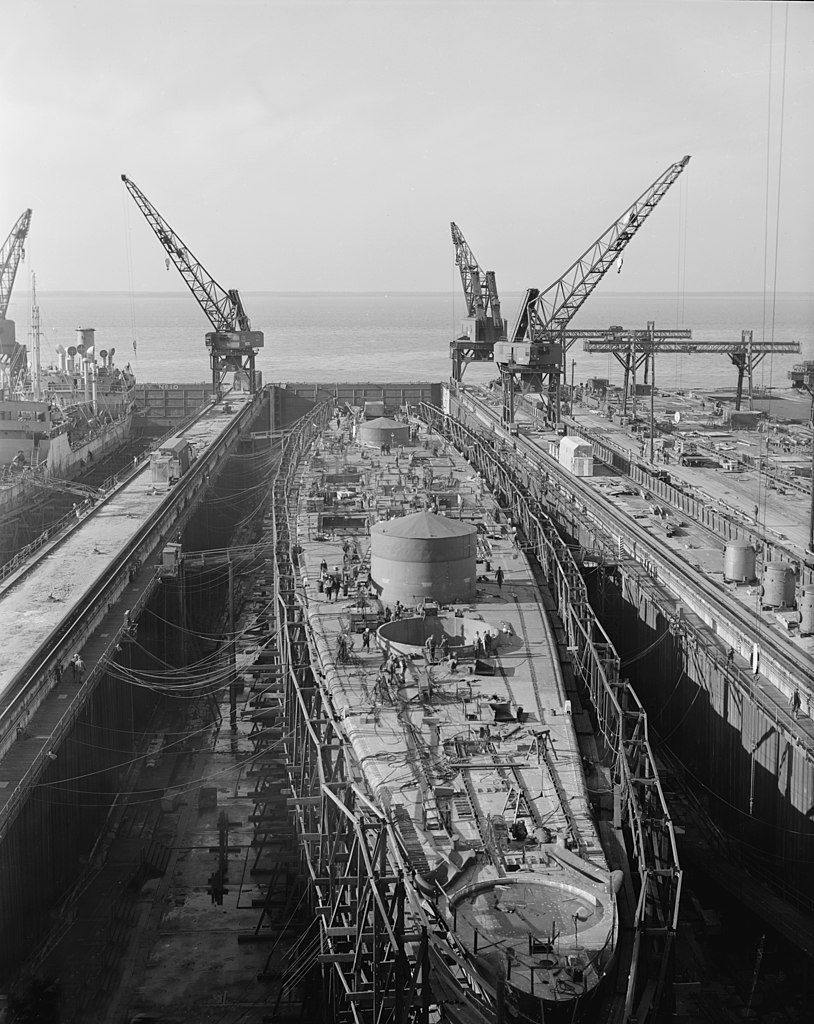
The Des Moines class were the largest US cruisers ever built -exception made of the odd “Large cruisers” of the Alaska class. At 17,255 long tons (17,532 t) standard displacement and 20,933 long tons (21,269 t) full load, this was more than the largest post-WW2 US missile cruiser, USS Long Beach. It was larger than the rebuilt Albany class missile cruisers, and almost twice as heavy as the last generation of missile cruisers, between the Leahy, Belknap, and even the nuclear powered California and Virginia class. By the way the latter had more than three times less crew.
By size, she was not the longer though, again beaten (by a slight margin) by USS Long Beach, but she was beamier from one meter at 76 ft 6 in (23.3 m). Her waterline Length was a well rounded 700 ft (213.4 m) for 716 ft 6 in (218.4 m) overall. Her generous draft 22 ft (6.7 m) was result of her cavernous machinery spaces and improved ASW protection, probably the best any US cruiser had, even compared to the Alaska class.
As usual for US cruisers, she kept a roughly 1/10 hull ratio for speed, with very fine entry lines thanks to the first barbette being put way aft from the bow. This was the same philosophy as for the Iowas. The greatest beam was reached roughly at the level of the aftermost pair of 5-in/38 turrets and aft FCS mast. She had a rounded stern, but with fine ends at waterline level, again for optimized water flow and speed, less turbulences. At this day and age of the guns still ruling the seas, speed and manoeuver still mattered with opponents first being IJN heavy cruisers.
The superstructures were not designed with particular care for lightness, alrhough as usual they partly used aluminium or simply soft steel in part and in any case, moderately thick sheating and some STS in more vital parts. This was all out of the properly armoured CT and barbettes, plus communication wells to the FCS and secondary turrets. The superstructure design benefited from a great deal of past design experience. It was really optimized to free space for the optimal fire arc for all weapons, and “clean” with less protruding elements and clear placement of the FCS masts and surrounding systems.
For example the main bridge superstructure, albeit still relatively narrow, was longer and bulkier than for the Oregon City or even Balitmore for that matter. As the ships were though out as possible flagships, there were three base levels from the weather deck and two bridges, one admiral bridge and the navigation bridge above. No tower like struture like on the Alaska. Also unlike wartime bridges, dotted with portholes, the Des moines class bridge was generously glassed with squared windows, prewar style for maximal visibility. It was defined during completion, which was postwar. The roof supported the two fore FCS, forward main and AA battery.
Then came the foremast, the largest, thickest of the two. Not a tripod, it was strong enough still to support future radar upgrades and carried anyway the main platform for a main aerial warning radar and secondary on a deported half-mast, plus antennae.
After this came the sole, tall main funnel, in which the two forward, two aft boilers exhausts were truncated in. The funnel was divided between the two main lines pairs for and aft and had a deflecting cap. At its base were located air intakesn ventilations grilles and machinery accesses.
After it was located the aft main suprestructure, much lower, and following the smaller mainmast carrying the remaining sea warning radar.
This three-storey structure supported the two aft FCS systems.
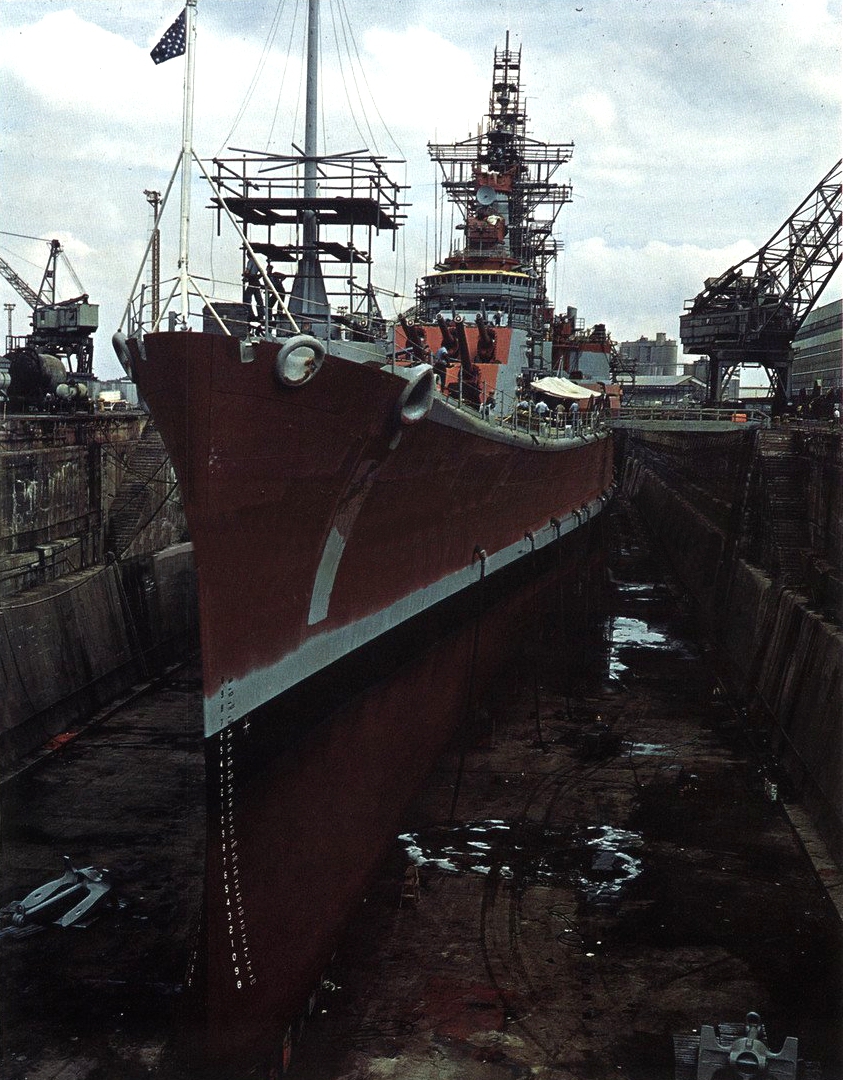
The six secondary DP turrets, quad Bofors and their numerous guidance system towers were arrays all around this central structure.
Past “C” main turret was located a hangar and its rail-mounted large access hatch, wide and long enough for a Vough Kingfisher (in 1943) or Curtiss SC (at completion) seaplane. As usual both catapults were served by a unique lattice crane. Propeller guards were installed on the hull either side aft of the “C” turret. This was an optimized design which was now a standard.
Armour protection layout

Protection-wise, the Des Moines diverged little from previous heavy cruisers in terms of armour figures and repartition. The citadel for example was 420 feet long, over 105 frames.
Belt: 4-6 in (102-152 mm). The thickest amidship, between A and C barbettes, closed by lower thickness bulkheads (5-in).
Deck: 3.5 in (89 mm). This was the main protective deck, located above the machinery spaces and protecting everything from “A” barbette to “C” Barbette, but with an extra stray above the ammunition storage spaces, in STS (likely 1.1 in) and the steering mechanism space aft. The battery and weather deck above had an intermediate thickness of about 1.1 in.
Main Turrets: 2-8 in (51-203 mm). The largest figure was for the forward sloped glacis, sides, lower back and roof.
Main Battery Barbettes: 6.3 in (160 mm), constant thickness on all perimeter. This went from above the weather deck down to the main armor deck.
Secondary Turrets: Same as the 5-in/38 turrets of all USN ships using them, with an armoured ammunition well below.
Conning tower: 6.5 in (165 mm). These cruisers were among the last built with Conning Towers. They disappeared in the 1950s. Due to their rounded shape, they were supposed to deflect and stop 8-in rounds. same for the main turrets. The deck was supposed to stop a standard 500 Ib AP bomb or deflect 8-in shell.
Some of these figures were an improvement over the Baltimore class.
However it should be said that the Des Moines’ citadel was much longer and taller compared to a Baltimore class overall, making for an increase in armour weight.
For example the Batimore’s Belt armor was the same, but the armoured deck went from 2.5 in (64 mm) to 3.5 in (89 mm), turrets back were thicker (2 vs. 1.5 in), but barbettes remained the same, as the conning tower but the Baltimore had stronger bulkheads (6-in vs. 5-in).
With a 1-in bomb deck to detonate armor piercing shells and high explosive bombs before reaching the main armor deck and a propoer 3.5-in armor deck, connected to the 6-in main belt, the Des Moins overall were able to not only out-range IJN heavy cruisers, but fight them while absorbing damage when the range fell. It was virtually proof against 5” gunfire and could still mitigae damage from similar ship’s armament.
As for the ASW protection, it comprised the usual machinery compartimentation in eight separate spaces (four boilers, four turbines), well protected ammunition storage rooms centered, the side spaces being used by empty compartments behing the belt and fuel-filled ones.
Powerplant
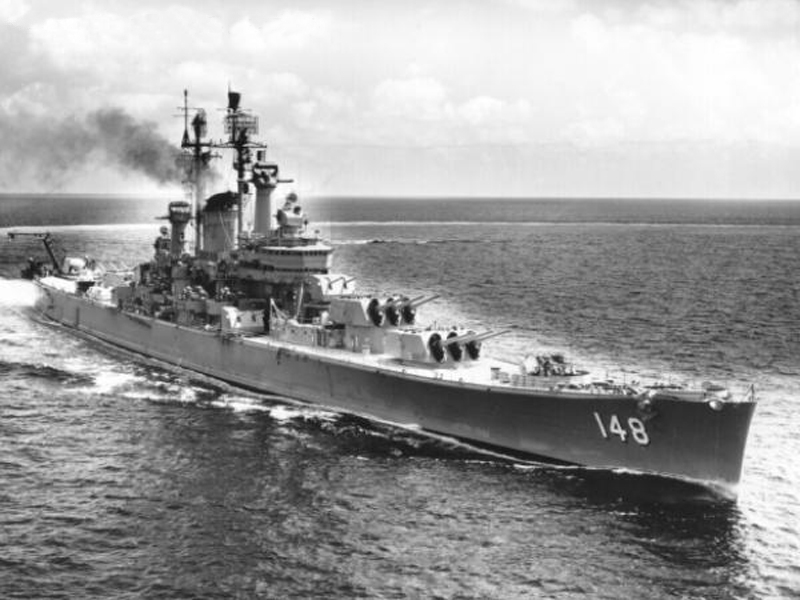
The Des Moines relied on a propulsive system repeated from the baltimore, with four four shafts, the usual inner and outer pairs, connected to four General Electric steam turbine sets (combining multi-stage units with HP, MP and LP level for cruising stage). They were fed by four admiralty double-ended multi-drum boilers (Babcock and Wilcox) for a grand total of 120,000 shp (89,000 kW), as usual outpassed on sea trials.
This enabled a confortable fleet speed of 33 knots (61 km/h; 38 mph).
As for range, she was credited to be able to cross 10,500 nmi (19,400 km; 12,100 mi) of ocean at 15 knots (28 km/h; 17 mph) cruise speed, with 3006 tons of oil. This was a bit more than the 10,000 nautical miles (19,000 km) of the Baltimores, as expected thanks to a slightly larger bunkerage. However how the significantly larger and heavier cruisers managed to reach the same top speed over the same output is a testimony to the knowhow of engineers in the uber-optimization of her hull lines (again, like the Iowas). This was helped by the longer and finer entry lines, which is evident when comparing the distance between the “A” batbette of a Baltimore and one of the Des Moines. All this was helped by the lifting of course of all treaty limitations. Extra tonnage meant extra possibilities when well used.
Armament
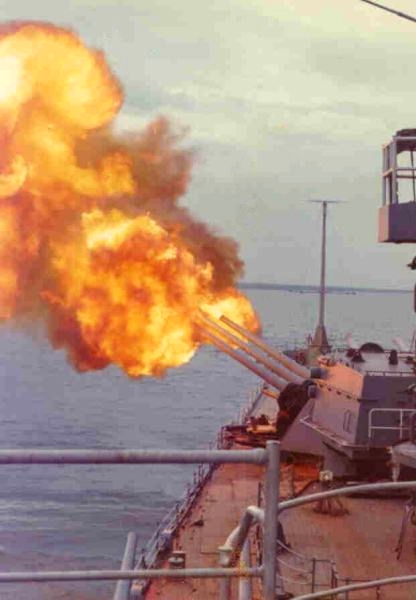
USS Newport News firing in Vietnam, 1972
Main: Nine Mark 16 Mod 0 8-in/55 guns
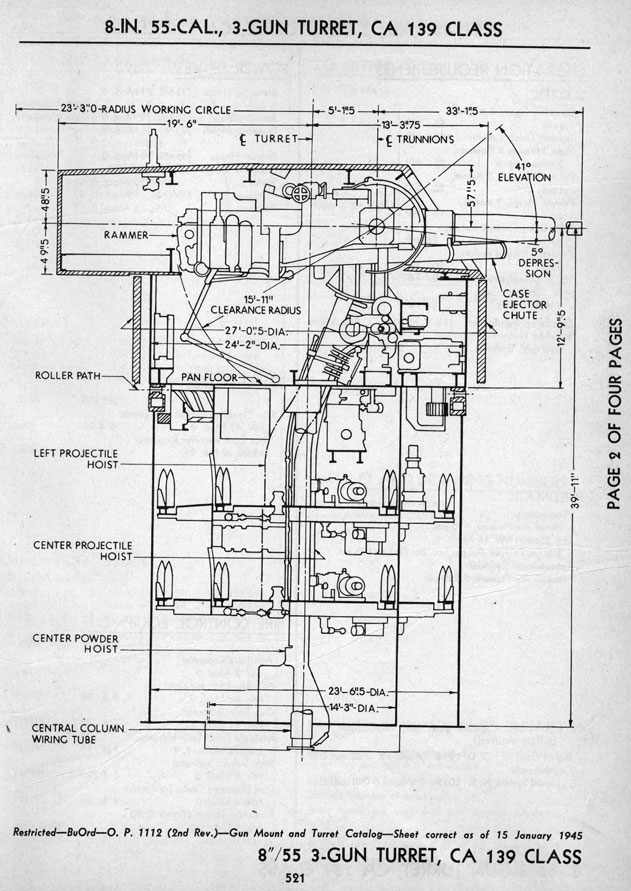
8-in/55 main gun Mark 16 turret internal scheme
First 8-inch guns using separate, rather than bag ammunition, and first (chrome-plated) loose-liner guns in the USN, first which also could load at any angle. The challenge has been to design a workable automatic shell handling and loading (basically an autoloader decades before it was adopted on tanks), which enabled thrice the fire rate of the previous standard ordnance for heavy cruisers. Coupled to the new “super-heavy” AP projectiles this made the Des Moines (CA-134) class the most advanced and powerful conventional cruisers ever built in any navy (again, exception made to the Alaska class which were more capital ships than cruisers). The naval ordnance could praised the fact that it was one of the few automatic gun designs which actually worked, it was reliable. This was in stark contrast to the Worcester‘s infamous twon 6-in gun turrets, which wre a failure causing these ships to be retired prematurely after barery a few years of active service.
There was a hitch though. The new turrets with their complicated loading mechanisms and separate ammunitions rose in weight, practically reaching twice that of the previous Baltimore class turrets. And they “consume” still the same crew as for a conventional turret, which was not ideal. But this was better than for the Worcester turrets and the naval board at last has its “rapid firing” heavy cruisers asked since 1940.
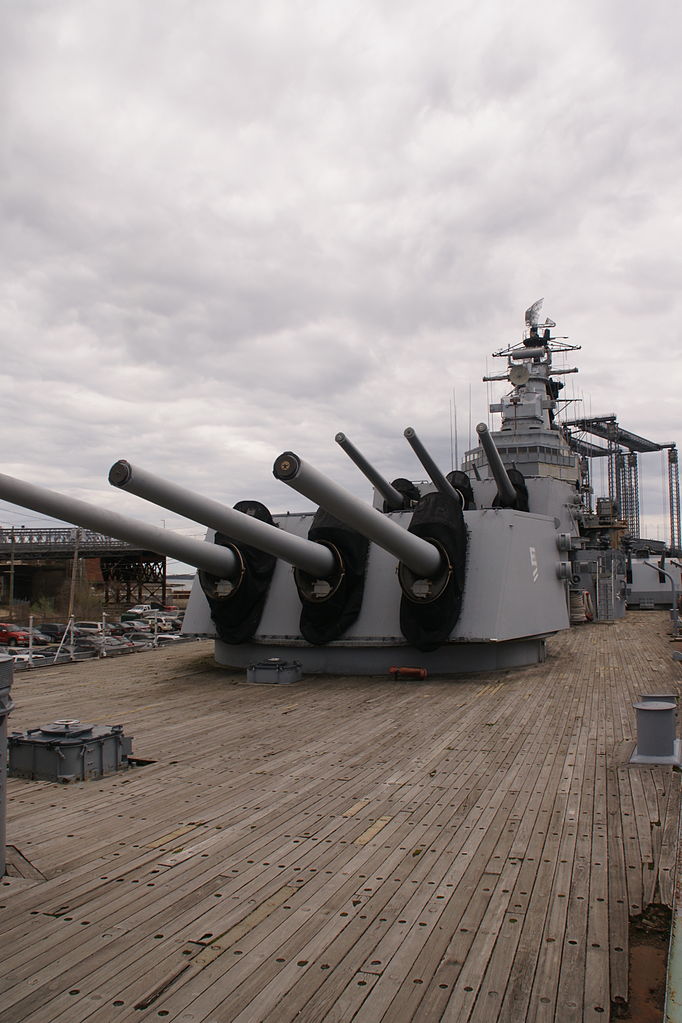
USS Salem C turret, seen from port bow looking astern. These were massive turrets, weighting 451 tons (458 mt) apiece, capable of an elevation of -5/+41° at a rate of 8.2° per second
and could train at +150/-150 degrees on either side at 5°/sec.
Missing WW2 and used already in Korea theese guns gave their full measure in Vietnam. However there was a serious premature shell explosion by October 1972 on USS Newport News in “B” turret, killing all 20 crewmen. The later enquiry revealed a faulty auxiliary detonating fuze which spread to the cartridges in the ammunition hoists, causing the whole barbette to go in smoke and light. The cost of repair had the turret closed off until the ship was decommissioned. This was a reminder that despite the cost-effective solution of shells compared to missiles, it was still a dangerous job.
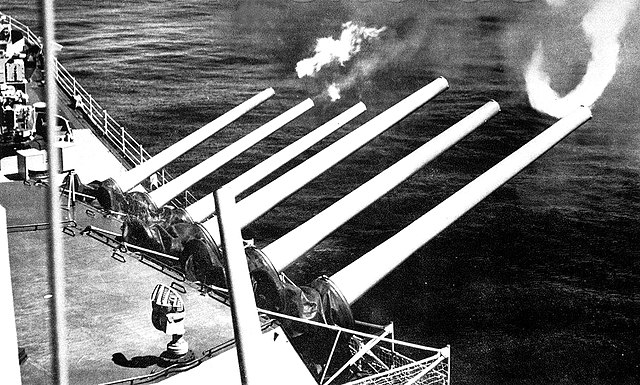
USS Salem fires in Korea, 1952
Quick specs:
Weight 17.14 tons (17.4 mt), 449.0 in (11.405 m) long.
Rate Of Fire 10 rounds per minute
Shells AP Mark 21 Mods 1-5 super heavy 335 lbs (152 kg) or HC Mark 24/25 260 lbs (118 kg)
Muzzle Velocity Full charge AP 2,500 fps (762 mps) HC 2,700 fps (823 mps)
Magazine capacity (per gun) 150 rounds, total 1,350
Max Range 41°: AP 30,050 yards (27,480 m), HC 29,800 yards (27,250 m)
Best armor penetration: 10.0″ (254 mm) @ 10,800 yards (9,880 m)
Secondary
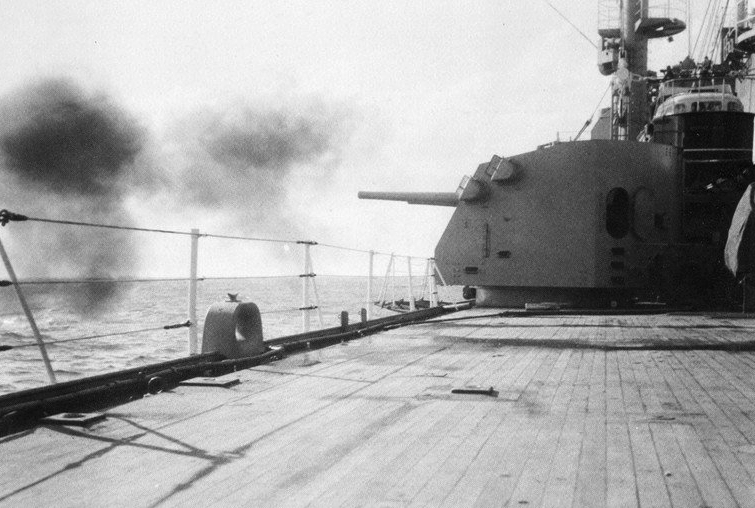
The secondary armament was kept from the drawing board to the end of their career in the 1980s. Like the Iowas, they retained their suerlative 127mm (5-in)/38 Mk 32, the last and best evolution of what most historians now labels “the best dual purpose artillery of WW2”. The type has been seen on detail in the weapons encyclopedia
Sufice to say that six were present mounted in the same arrangement as previous cruisers of the Baltimore and Cleveland class: One axial at each end of the superstructure, superfiring over the main turrets and four more, two per side, at deck level. This now largely accepted and combat-proven configuration gave them the best fire arc. They were assisted by the Mark 25 Radar.
Anti-Aicraft Armament
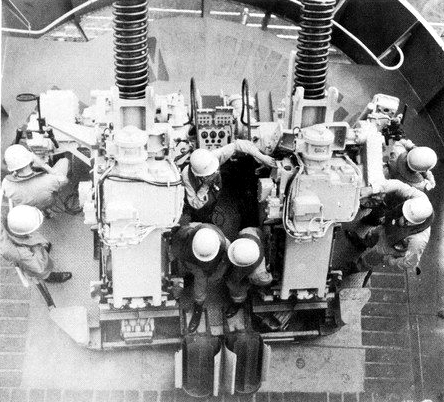
The initial plan in 1943 was to have them armed with a battery of sixteen quad 40mm Bofors (64 barrels): Four each side in a lozenge pattern amidship in surelevated mounts to give them a clearer arc, two mounts axial on the foredeck, one directly atop the bow, and another aft, and two side by side at the poop, with the crane in between. Full specs.
The original ONI scheme also shows another battery of twenty single-mount 20 mm/70 Mark 24 Oerlikon in various deck positions, and six in superstructures. This was low to WW2 standard, but it was well understood in 1945 that they were far less efficient than the 40 mm. Full specs.
When completed in 1947-48, the 20mm/70 were still there as a “guarantee” despite the replacement of all 40 mm for new 3-in guns, but in twelve twin 20mm/70 Mk 24 as they took not that much space. Gradually during their career this was reduced.
At completion in 1947-48 however, the ordnance came up with its promised Mark 22 twin mount 3-in/50 guns. This was the “3-inch revenge”, after being sidelined from USN service on major ships in favor of the trio 5-in/38, 40mm and 20mm AA. The veneral 3-in/50 went back to WW1 and had one of the longest history of any US ordnance, even compared to the 5-in/38.
However in 1945-48, what happened was the jet. With speeds up to 800 kph or more, no AA guns was to be adequate. New superfast, automated, hard-hitting, radar-guided ordnance was needed.
The new 3-in/50 was designed to replace both the Oerlikon 20 mm and Bofors 40 mm and it was discovered that its initial requirement to shoot down fast incoming kamikaze attackers at short ranges could be used against early jets as well.
The 3″/50 however was nothing without its Mark 22 mount, semiautomatic (power-driven automatic loader) and the ordnance managed to crame them into a twin mount that was about the same size as the former quad Bofors 40 mm. It was a no-brainer and the admirakty board soon asked revisions of the specifications to replace the quads as a one-per-on basis. This however reduced the numbe rof barrels to 32, still impressie though. In the 1950s these were upgraded again to Mk.33/34 mounts. Only critic was they used an open-base-ring type. They could elevate from 15 to 85° at 24°/s but their on-mount magazine was still assisted by two loaders.
Each had a crew of eleven men and used proximity fuze, fire-control radar for 50 rpm with great accuracy, at least until supersonic jets and cruise missiles arrived. They were thus gradually reired from the Des Moines class cruisers. At the time of the Vietnam war, they only kept six mounts amidships, three either side.
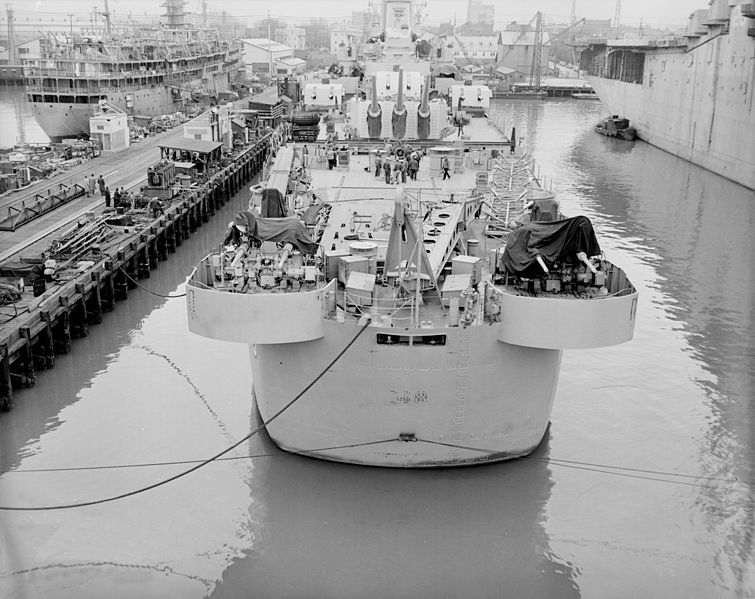
Full review of the 3-in/50 Mark 22.
Sensors
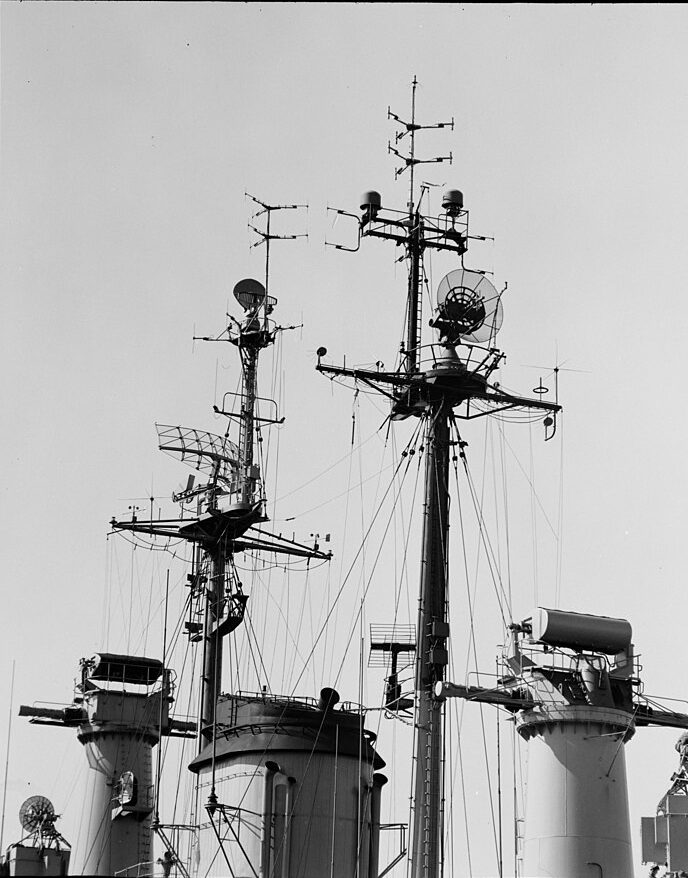
The fire control rested on two Mk54 (main battery), four Mk37 (secondary), and four Mk56 FCS (AA battery):
To go further, they had also a SG-6, SK-3, SPS-6 radars. Initially they were given two Mk 13 (8-in/55), four Mk 25 (5-in/38), and four Mk 35 FC (3-in/50) radars
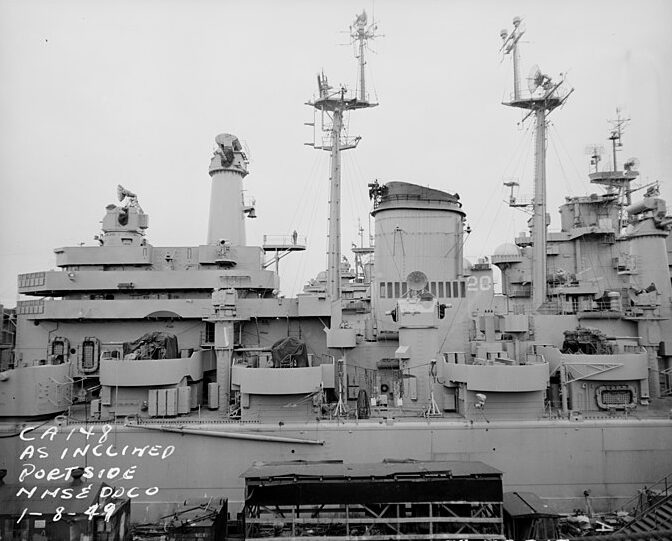
Air Group
In 1946, the three cruisers were initially assigned the latest USN seaplane in service. This was for a short while however. Between improvements in radars and the Korean war, their poop deck was converted as an helicopter spot at completion, and reinforced. Catapults were removed. During their long cold war career they operated all sorts of helicopters, however it seems their aft hatch and hangar was used for extra boats. So these were not fully resident, mostly used for liaison rather than econaissance or ASW patrols at least until 1966.
The modernization project aimed at correcting this and procure them a large spot and permanent hangar for two, probably Sea King models.
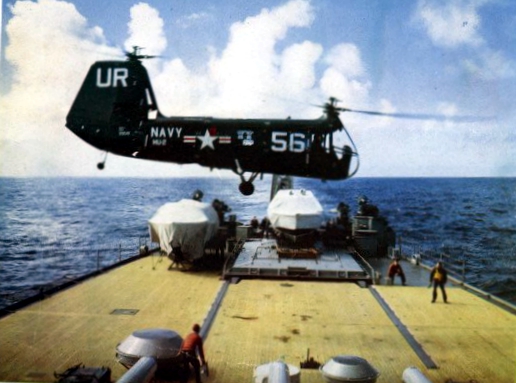
HUP-2 taking off from USS Newport News in 1955
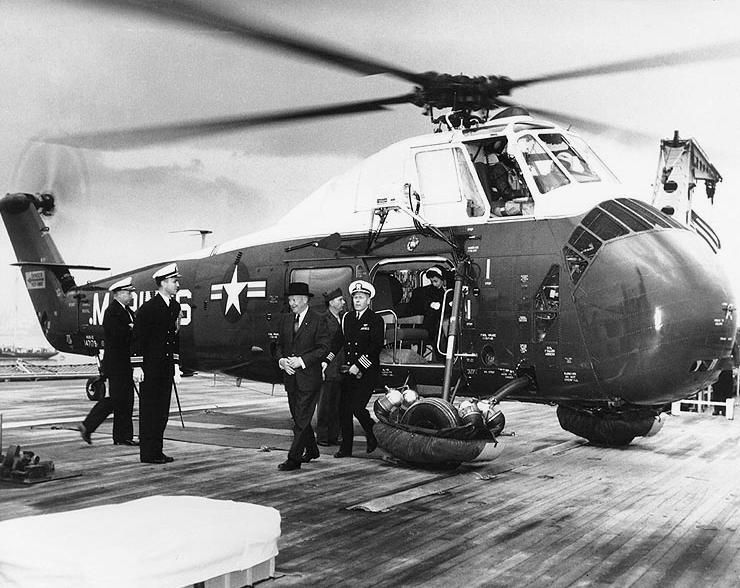
President Eseinhower landing from a Sikorsky H34 on USS Des Moines in Athens, 1959
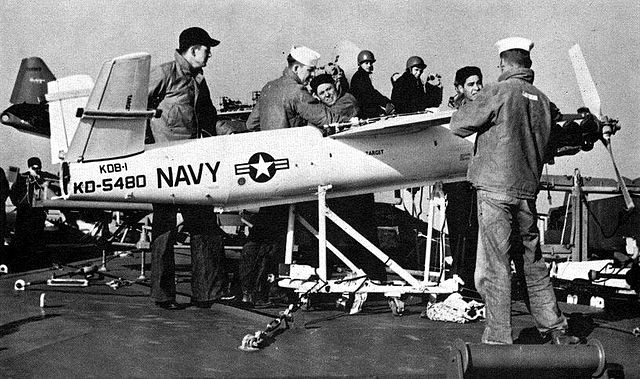
Target drone being prepared to be used from USS Newport News in 1960
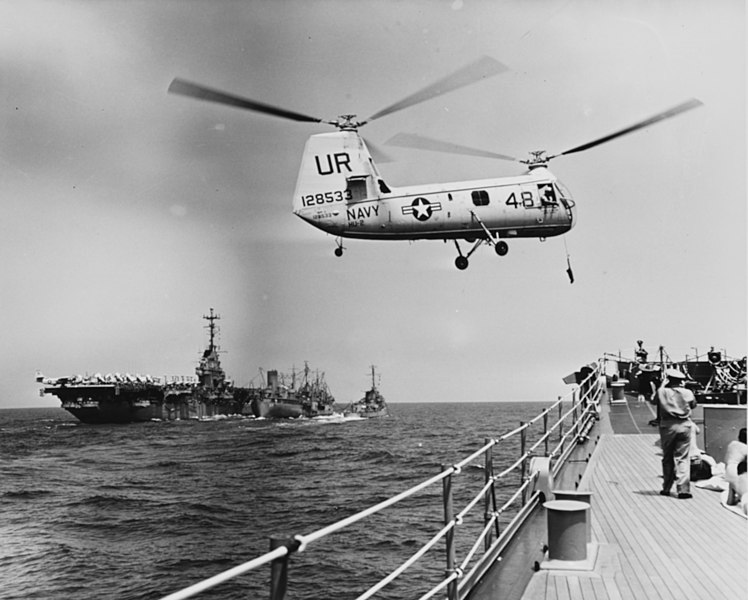
Piasecki HUP-2 Retriever
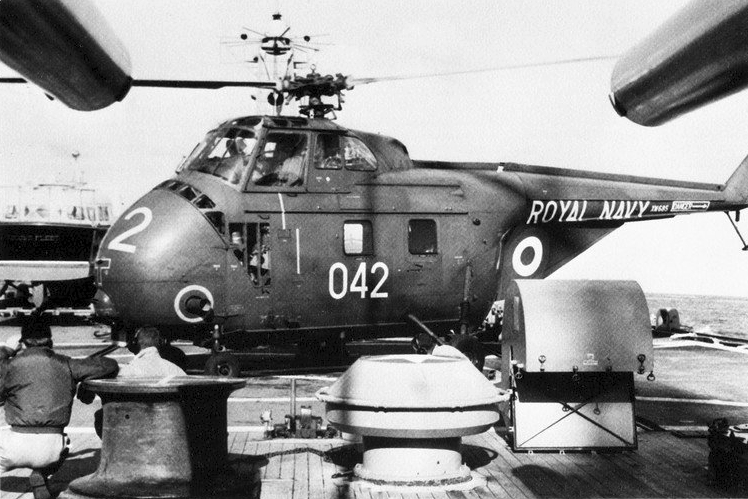
Westland Whirlwind on USS Newport News in 1966
![]()
UH-2B Seasprite HC-4 taking off from USS Newport News in 1966.
Modernization and projects
Upgrades
In 1952, their single-mounted 20 mm guns were all discarded and replaced in some position by twelve twin 20mm/70 Mk.24 AA mounts.
About the same time depending on their overhaul schedule they saw the removal of their WW2 SK-3 and SPS-6 radars for replacement by the new SPS-6C, SPS-8 radars and the SLR-2 ECM suite
In 1959 all had two 76mm/50 mounts removed
In the 1960s, USS Salem has her SPS-6C radar removed and replaced by an SPS-12, and two new Mk 34 FC radars
In 1962 USS Des Moines had a twin 76mm/50 removed.
In the 1970s they all had their SLR-2 ECM suite removed as obsolete but not replaced.
Reconversion Projects
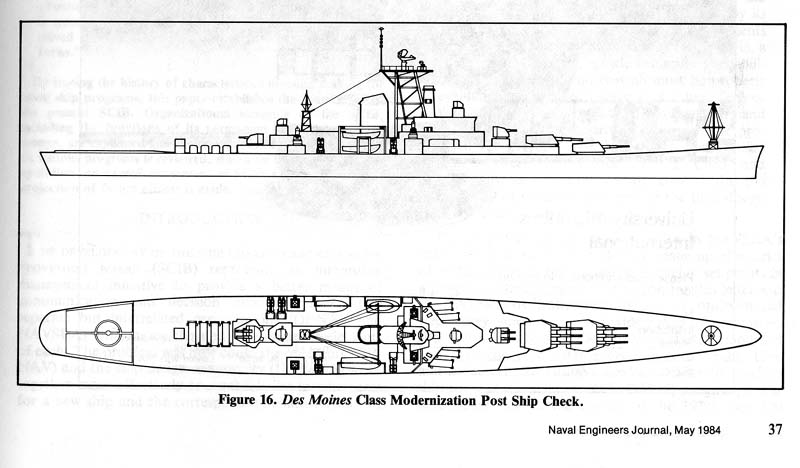
Just like the Iowa class, miraculously preserved up to that point, the Des Moines were seen still as valuable “gun wagons” usable in a context of reinforcement of the Soviet Navy capability in high seas large combat ships, notably rumors about the Kirov class cruisers construction started to percolate in US intel and plans were made to convert either the Des Moines or the Iowa class. Initially the Des Moines were preferred as being less costly to operate. However under the Reagan administration the Iowa were chosen instead, and the conversion cost basically was considered too much of a burden (with its usual costs overruns) to cancel any such conversions on the Des Moines class which instead were on the way to decommission.
It’s not as if the admiralty board not have though about the best way to have these large cruisers upgraded. After all, they were larger, and thus more “upgradable” than the Baltimore class, notably after the painful experience of the Albany class. Being bulkier, the Des Moines offered more stability, notably to face intensive superstructures upgrades, radar and electronics aditions in general.
One plan that soon became evident, was like previous WW2 cruisers conversions, keeping their A-B main forward turret but having essentially the aft part completely transformed to launch missiles. They would have kept their main asset, speed and armour protection which none of the dedicated missile cruisers in the USN possessed at the time, being much more resilient to missile attacks, like the Iowa class. The still also could bring their artillery to bear in any shore operation.
In 1981 the survey led to no official proposal but the three Des Moines ships were examined versus the reactivation of the the Iowa-class for NGFS and Tomahawk support. The turrets would have been partially removed for Talos launchers or even like the Albany class, total redesign of the superstructure with Talos, Terrier and ASROC. However if being flagged as acheaper alternative for modernisation than the Iowa class, report concluded their lack of deck space was an issue, and second, that if kept as artillery ship, they were less capable than the Iowas again.
⚙ specifications |
|
| Displacement | 17,255 l.tons standard, 20,933 long tons ull load |
| Dimensions | 700 ft wl/716 ft 6in oa x 76 ft 6 in x 22 ft (213.4/218.4 x 23.3 x 6.7 m) |
| Propulsion | 4 shafts, 4 steam turbine sets, 4 boilers= 120,000 shp (89,000 kW) |
| Speed | 33 kn (61 km/h; 38 mph) |
| Range | 10,500 nmi (19,400 km; 12,100 mi) at 15 kn (28 km/h; 17 mph) |
| Armament | 3×3 8″/55, 6×2 5″/38, 12×2 3″/50, 12× 20 mm Oelikon AA |
| Protection | 4-6 in, Deck: 3.5 in, Turrets: 2-8 in, Barbettes: 6.3 in, Conning tower: 6.5 in |
| Sensors | AN/SPS-6 air-search radar, SP fighter directional radar |
| Onboard aviation | 2× aircraft catapults, Curtiss SC Seahawk |
| Crew | 1,799 officers and enlisted |
General Assessment
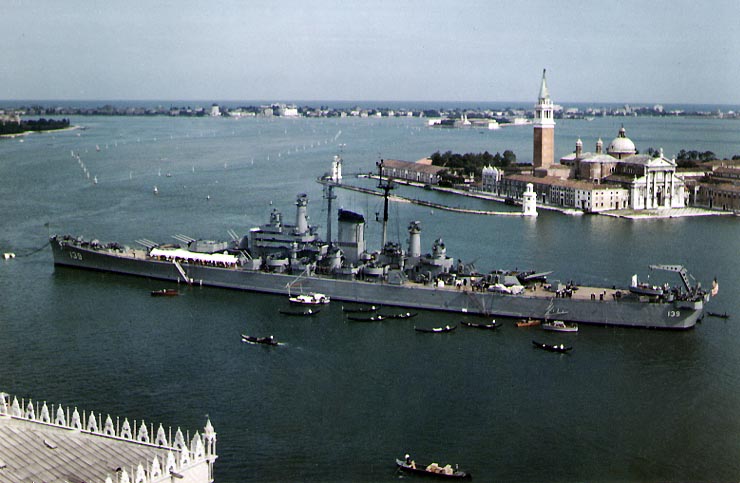
USS Salem in Venice, 23 August 1951
All in all, not only these cruisers had far better guns than the Worcesters and a career infintely superior and longer, but they were the most active conventional cruisers of the USN, an exception when missile cruisers became the norm, and despite a major modernization. They stayed “in their juice” until the end of the cold war because of their “special status” of principal artillery ship of the USN, creating their own niche and utility at a time most WW2 were disarmed. For example their rapid firing and accurate capability was seen as a decisive advantage, not in any classic naval engagement (that option after 1960 became far more remote).
But against a largely coastal country like Vietnam, and range up to 25 km inland (30,050 yards max) they could hit hard and fast any objective. Let’s use remember they could pour in at any target a saturation fire of 90 shells every minute. This could absolutely devastate any given strongpoint before it had time to reorganize or leave the area while bein far away from any possible counter-battery fire. In case of incoming aircraft, she had the support of the fleet and her own AA battery in last recourse was still largely capable to draw a wall of fire on any classic bomb-armed jet if needed.
In fact they compared favourably to the Iowa class battleships for the same role, being smaller and cheaper to operate but still faster-hitting at a roughly similar range. But ultimately not that easier or cheaper to upgrade and stay relevant in the 1980s.
In the end, if they gave satisfaction to the navy board for their “rapid fire heavy cruiser” too late for WW2, they proved their worth for the US taxpayer on the long run by their numerous support missions and still impressive in “showing the flag” missions as well. Their artillery capability was just unparalleled in the USN during the entirety of the cold war, although only NewPort News was really put to contribution on that matter. Des Moines and Salem were decommissioned in 1961 and spent decades of maintained reserve, pending modernization and reactivation. Ultimately the Iowas were chosen over them for Reagan’s grand fleet.

USS Newport News and USS Enteprise in 1962
USS Newport News bercame the most decorated of all three cruisers: She had the Combat Action Ribbon, Navy Unit Commendation with star, Meritorious Unit Commendation, Navy “E” Ribbon (For “execellence”), Navy Occupation Medal “Europe”, National Defense Service Medal with star, Armed Forces Expeditionary Medal, Vietnam Service Medal with three campaign stars and Republic of Vietnam Campaign Medal.
Her Vietnam war 1968 first Navy Unit Commendation, presented to Captain Snyder by Rear Admiral John Wadleig mentions “for Exceptionally meritorious service from 2OCT67 to 26APR68 while engaged in operations against enemy aggressor forces in the waters contiguous to the hostile coastline of both North and South Vietnam.”
She was awarded the “Top Gun” award for support in 1969, Navy Meritorious Unit Commendation for performance. Her Battle Efficiency “E” was FY 1972. Her 13 July 1973 second Navy Unit Commendation (Capitain Kelly by Vice-Admiral Finneran was for her 1972 Vietnam deployment).
The Des Moines class in services
 Des Moines CA-134
Des Moines CA-134
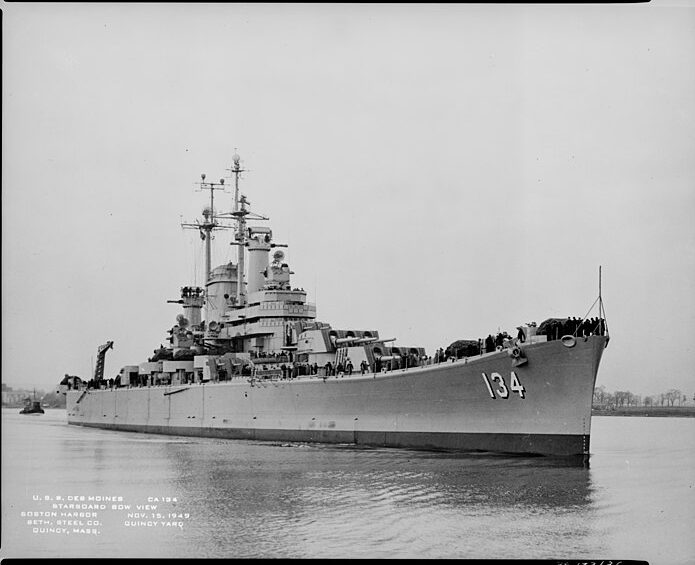
USS Des Moines (Iowa’s capital) was launched 27 September 1946 by Bethlehem Steel Company (Fore River Shipyard in Quincy, Massachusetts), commissioned 16 November 1948. First of her class she was also given the new Sikorsky HO3S-1 utility helicopter and had no seaplane from the start, her catapults not being mounted.
After the usual sea trials and her shakedown cruise on the east coast down to the Carribean, some yard workout, she was given a varied operating schedule according to the needs of the foreign policy at the time.
USS Des Moines was homeported at first to Newport, Rhode Island in 1948-49. After 1950, she was based in Norfolk, Virginia for exercises in the Caribbean and along the East Coast up to Canada. But she was also deployed abroad, in the Mediterranean and North Atlantic. For her first Med Tod, in 1949 and 1957 and was for seven years flagship of the 6th Task Fleet (6th Fleet from 1950). In 1952, 1954, 1955, 1956 and 1957, she carried midshipmen for their summer training cruises, which also comprised stops in Northern European ports. In Northern Europe she took part in NATO exercises for 1952, 1953, and 1955. On 18 February 1958, she made her last 6th Fleet deployment until July 1961, placed out of commission, and in reserve.
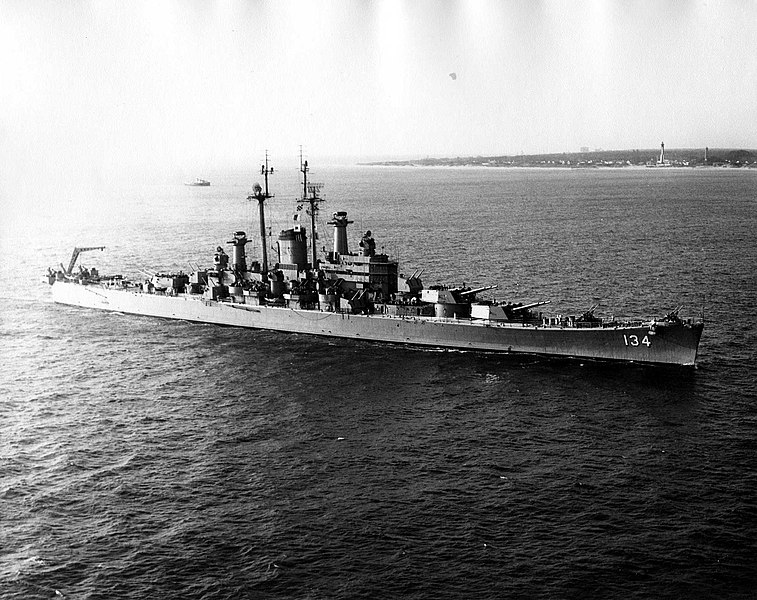
When in the Mediterranean, USS Des Moines bolstered the 6th Fleet in showing the flag missiones, stopping in Southern Europe, Northern Africa ande Near East through many NATO Mediterranean exercises. She mad port calls at Rijeka (1950) Dubrovnik (May 1960) and others. She was present during the Suez Crisis of 1956 and the Lebanon crisis of 1958. She starred in a movie both as introduction and conclusion of the movie “John Paul Jones” with Robert Stack in 1959.
After her decommissioning in 1961 she was mothballed at the South Boston Naval Annex. She was placed at the Naval Inactive Ship Maintenance Facility, Philadelphia (maintained reserve – meaning she coule be reactivated in a short notice). In 1981, the Congress wanted to perform a thorough survey of Des Moines and Salem for reactivation in lieu of two Iowa-class battleship as they were believed more cos-effective for the Reagan administration “600-ship Navy”. The study concluded there was not enough deck space for Tomahawk cruise missiles, Harpoon anti-ship missiles, Phalanx CIWS mounts, radars and communication systems required to safely operate in the 1980s. Per-ship cost for reactivation and updates were about the same for the Iowa, which still had a better protection free room and armament. In condequences both were struck off the reserve in August 1993.
The council of Milwaukee in Wisconsin wanted to pirchase her to turn her into a museum ship but the bid failed to reach the financial reserve. The navy decided to sold her eventually in 2005, after decades of reserve. USS Des Moines was towed to Brownsville in Texas, for scrapping which was completed by July 2007. However two of her dual 5-inch/38 gun mounts had been donated to the USS Lexington museum (Corpus Christi). Her bell, nameplate and plaque are now visible at Camp Dodge, Johnston in Iowa. Her port anchor is now at the center of a roundabout at the entrance to Quincy, Massachusetts, close to USS Salem Museum.
 Salem CA-139
Salem CA-139
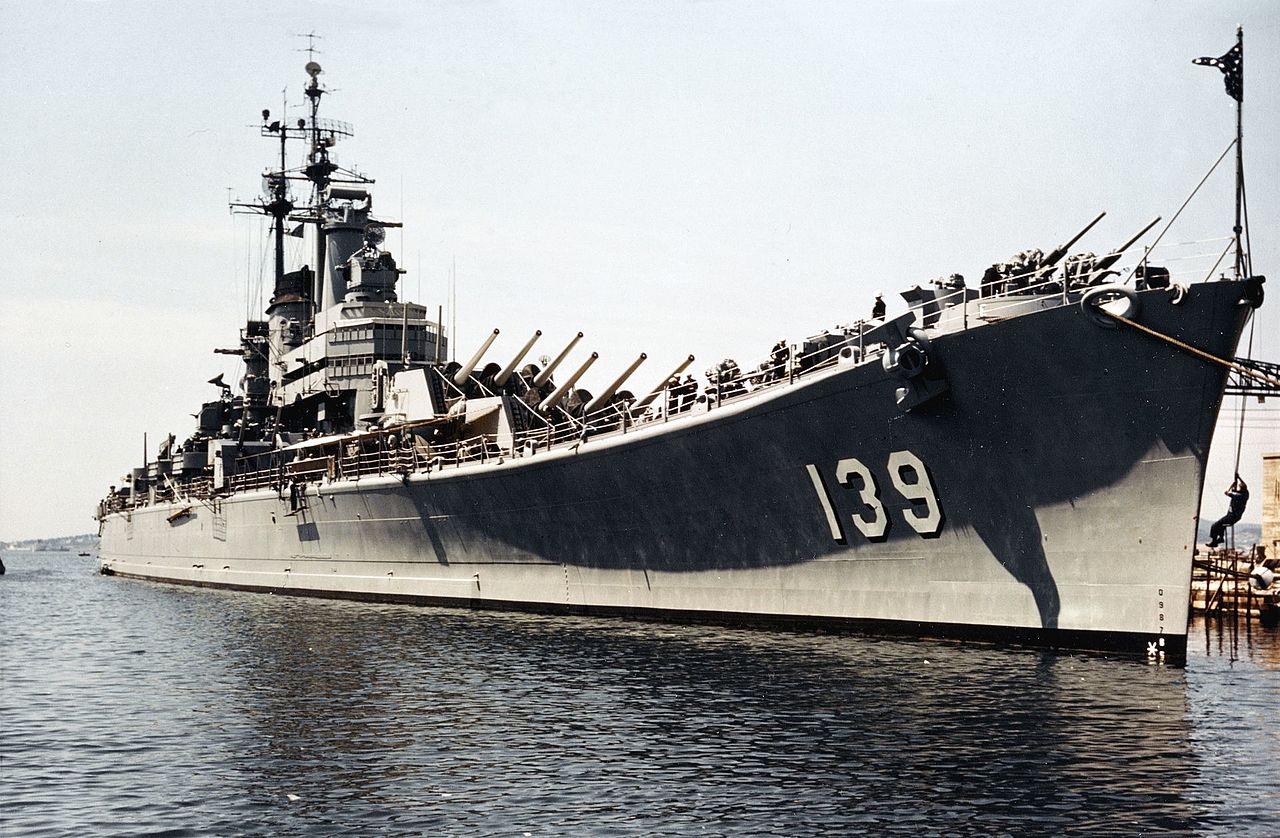
USS Salem was built at Bethlehem Steel Co.’s Fore River Shipyard in Pennsylvania. Laid down on 4 July 1945 as the war was about to end, she was launched of 25 March 1947 and Commissioned on 14 May 1949. After a visit her namesake city of Salem in Massachusetts on 4 July 1949, she performed three months of shakedown to Guantanamo Bay in Cuba until October 1949 and post-shakedown fixes at the Boston Navy Yard. Two complementary cruises followed to Guantanamo in November and December 1949 and exercizes in the Atlantic Fleet in early 1950.
On 3 May 1950 she sailed to her forst Med Tod, relieving on 17 May her sister USS Newport News (CA-148) as flagship for the 6th Fleet, Mediterranean. She would make seven deployments there as fleet flagship, stopping in Malta, Italy, France, Greece, Turkey, Lebanon, and Algeria while NATO training all along. On 22 September she was replaced by USS Newport News and returned home to wait for more instructions.
After exercises on the coast of new england she joined the Atlantic Fleet for maneuvers and from 3 January 1951, spent six weeks of intensive gunnery training, at Guantanamo in the context of a possible conflict. After some training off Bermuda in March she returned in the Mediterranean to relieve Newport News, still as flagship. On 19 September she was relieved in turn by USS Des Moines and back home she had four months of overhaul at Boston.
By February 1952, she had a refresher training and until late March post-fixes. On 19 April, she made her third Mediterranean deployment, relieving USS Newport News at Algiers (28 April 1952). Her most important Exercise was “Beehive II” that year, working as part of a task force comprising the British, Italian, French, and Greek navies. Des Moines relieved her on 29 September for upkeep at Boston on 9 October, followed by four months of local operations.
She returned to the Mediterranean on 17 April (relieving Newport News) taking part in Exercise “Weldfest” and taking part in an emergency relief after the 1953 Ionian earthquake, first American on the scene, staying there until her own stocks ran out and relieved by Des Moines in October. Back at Boston on 24 October she had a shipyard overhaul and by February 1954, after her usual post-overhaul trials and refrsher at Guantanamo Bay, she left Boston on 30 April for the Mediterranean, becoming 6th Fleet flagship. She was relieved by USS Des Moines at Lisbon (22 September) and back to HP Boston on 29 September followed until November 1954 to Atlantic Fleet exercises and manoeuvers.

Salem also took part like her sister in a 1956 movie. She was used to imperson the German pocket battleship Admiral Graf Spee in the famous feature film “Battle of the River Plate”, now free on youtube. For history buffs however her appearance was nothing like the real ship, which was much smaller, and very different in appareance. She still sported the same pennant 139. But for the general public of the time, far less informed that today, she was menacing and fit the part well with her large turrets. The rest of the movie sported however many authentic RN ships still in service at the time, both from the RN and RAN, including some present at the time (two leander class, one County class), plus models for the battle, showing Exeter damaged and apocalyptic destruction of Graf Spee after the diplomatic game in montevideo. Still a reference of the time with “sink the bismarck”.
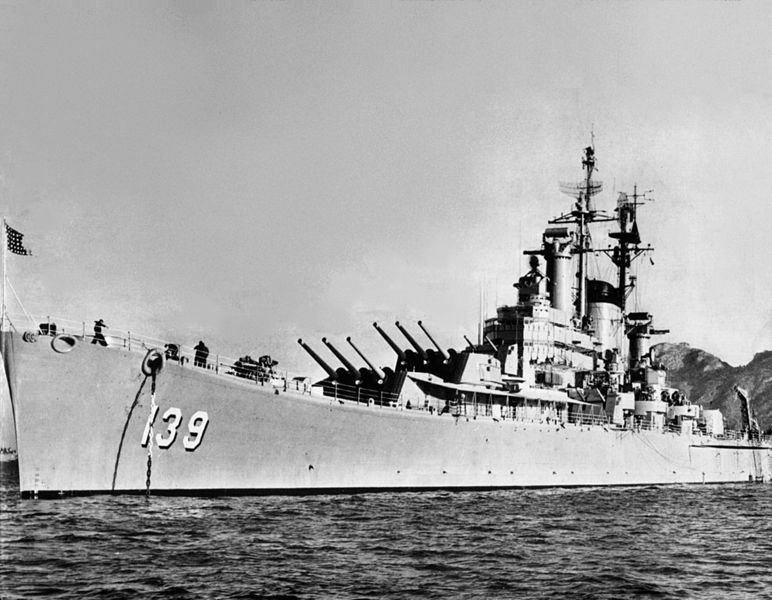
USS Salem in 1957
After her January-February 1955 cruise to Guantanamo Bay she was back to the Mediterranean as usual in May, relieved USS Newport News. In this 6th deployment, she took part in a NATO exercise and Franco-American naval exercise. For this, she carried Under Secretary of the Navy Thomas S. Gates as an observer aboard. She was back to Boston by October 1955, followed by a four-month overhaul.
The routine went on by February 1956 (Guantanamo) followed by assignment as 20-month flagship for the 6th Fleet, HP Villefranche-sur-Mer, on the French Riviera and back to Boston on 5 April, but soon seeing deployment during the Suez Crisis, then to Rhodes on 14 May until mid-June and by April to August 1957 she showed the flag and US support for the government of Jordan threatened by subversion. She departed for home on 26 June 1958, for Norfolk and an overhaul, her crew dismbarking on the 4 of July.
In 1958, she returned to the Mediterranen, showing the flag off Monaco to celebrate the birth of Albert II (son of Rainier III and Princess Grace Kelly). Back home she was however scheduled for inactivation; At the last minute this was not carried out and she returned to Lebanon on 15 August 1958 to foil a coup. Relieved by the command ship USS Northampton (built on a post-WW2 completed Oregon City class cruiser) on 11 August as flagship for the 2nd Fleet she arrived at Norfolk. She made a short cruise to Barcelona and back, entering the Norfolk Navy Yard on 7 October for inactivation, the Commander 2nd Fleet leaving her with the flag. She was decommissioned on 30 January 1959, placed in long reserve at the Atlantic Reserve Fleet, Philadelphia Naval Shipyard.
This reserve went on for decades, unlike most non-converted WW2 veterans (or the Worceseter class). Like her sister Des moines she received a survey from the Vongress in 1981 for possible reactivation and modernization under the Reagan adminsistration. lsthough still in excellent condition, her modernization was not funded as the Iowa class were chosen instead.
Was Salem about to be scrapped ?
In October 1994 indeed, while still pending her fate, so 13 years after the survey, USS Salem was sent to Quincy, Massachusetts to be turned into a museum ship, benefiting from a new presevation program, the United States Naval Shipbuilding Museum. She is not only a pretty sight, but houses the USS Newport News Museum and US Navy Cruiser Sailors Association Museum, US Navy SEALs Exhibit room, completely refitted with exhibition spaces and auditoriums.
However when the morring was proved unstable she was closed to tourists in September 2013 by the MBTA. The wharf was sold to private interests but she reopened on weekends from May 2015 and was to be moved to East Boston, until a deal was struck with the landowner in February 2016 so she stayed in the Fore River Shipyard, Quincy where her sister was built, and until at least 2021, fully reopening from April 2016. She was relocated again by August 2017 and from August 2019 only opens on weekends. She is still partially open today, including Fridays in the summer season.
 Newport News CA-148
Newport News CA-148
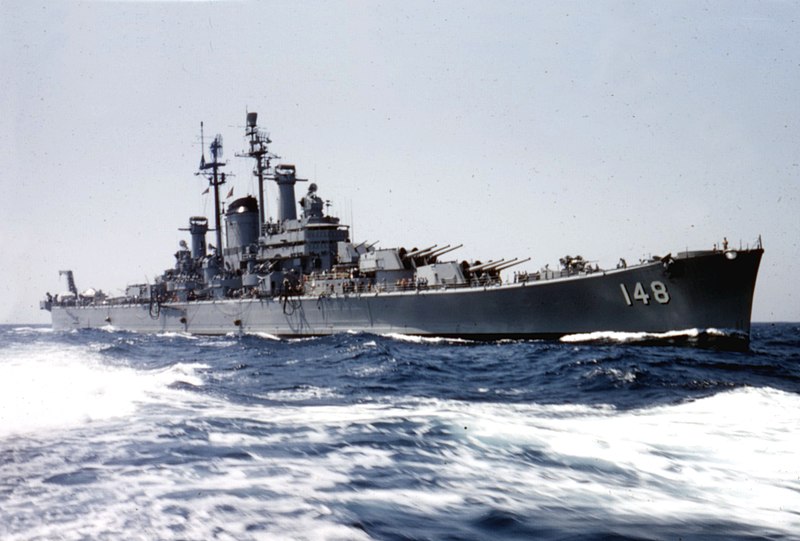
USS Newport News was laid down at Newport News Shipbuilding and Dry Dock Company in Virginian, on 1 November 1945, so after the end of WW2, launched on 6 March 1948 and commissioned on 29 January 1949, with Captain Roland N. Smoot in command. She had the longest career and was the most decorated of the three. After her sea trials, shakedown cruise in the Carribean, post-fixes, she started training with the fleet in 1950 and until 1962, multiplied like her sisters deployments to the Mediterranean (yearly 1950 to 1961) with the Sixth Fleet, and sometimes as flagship, alternating with her sisters. The other part of each year was spent in fleet exercises and midshipman training cruises in the Caribbean-Western Atlantic area.
Mediterranean service 1950-62.
Her first Med Tod from January 1956 was as flagship for Vice Admiral Ralph A. Ofstie and then Vice Admiral Harry Donald Felt while at Barcelona, before swapping to USS Salem in May while at Gibraltar and return to HP Norfolk in Virginia, not far from her shipyard. She was greeted by the inhabitants of eher namesake city for the celebration of 4th July holiday. While underway to Norfolk she carried out the first dependents’ cruise. From 16 July to 24 August there was a Midshipman Cruise as flagship, CruDiv 2, stopping at New Orleans, Balboa, Guantanamo Bay. She crossed the Panama Canal when RADM Ira H. Nunn relieved RADM E. R. McLean, Jr. but was back in September in Norfolk NyD for her first major overhaul.
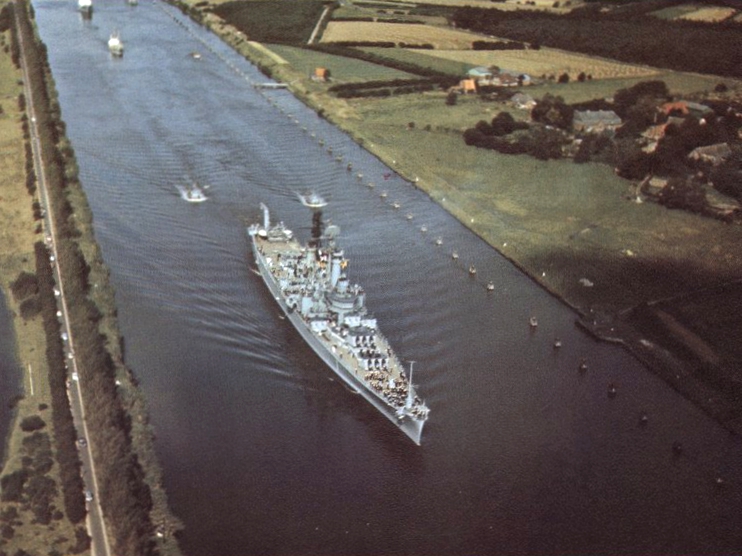
Newport News transiting the Kiel Canal in September 1962
September 1957 saw her in the Eastern Mediterranean for the Syrian crisis. In March 1960 she was ordered to take position northeast of Sicily and then to sail at full speed to Agadir in Morocco to help the survivors of the 1960 earthquake, making 1,225 miles in 40.5 hours at 31 knots, a record for any USN cruiser so far. She was there on 3 March, providing medical, food and material aid (notably electricity thanks to her generators). After the assassination of General Rafael Trujillo in Santo Domingo she was rushed there on 4 June 1961, but arrived when the crisis terminated and she headed for Norfolk.
Newport News as flagship 2nd Fleet Atlantic (1962-66).
The winter of 1962 overhaul saw the addition of communications facilities for the CiC 2nd Fleet. In August 1962 she took part in NATO RIPTIDE III followed by a tour in Northern European waters as flagship, COMSTRIKFLTLANT, 2nd fleet as planned. This was the last significant of her modifications.
This started in the mid-1950s with her forward bridge enclosed on both levels with glass windows and roofs to create an additional navigation bridge and flag bridge. Later she received radars and communication equipments upgrtades as well as better gunnery fire control systems. In 1962 she obtained a large deckhouse midships to make her a better flagship, with additional accommodation and office spaces for an extra 100+ admiral staff. She became the 2nd Fleet flagship, and still this became handy when commanding raids on the gunline in Vietnam later, notably during her two raids on Haiphong when she acted as raid flagship.
In October she was the flagship for the while Cuban Missile Crisis, protected by USS Leary. Both arrested the Soviet vessel Labinsk underwat, which was ordered back. In November she still acted as ComSecondFlt, but on station northeast of Cuba. She stayed until the end of the crisis, assisted in the missile count dismounted. After the quarantine ended, she was back to Norfolk for Xmas.
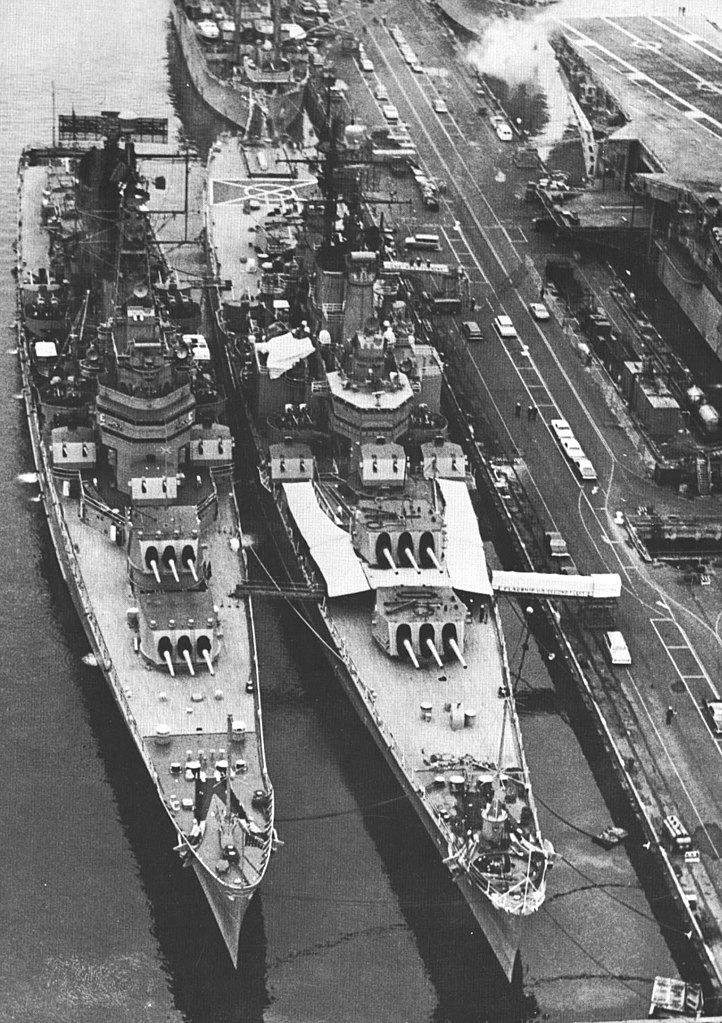
Newport News (right) alongside the guided missile cruiser Boston at Norfolk in 1966. The pic is very interesting as showing the difference in size between their forward turrets.
In 1963-1967 she stayed in her flagship role of the 2nd fleet, paerticipating in many NATO exercises in the North Atlantic and well gunnery and amphibious exercises, plus her usual summer midshipman cruises. The Dominican Republic crisis in 1965 saw her moving in April-May at Santo Domingo, for the Commander, Joint Task Force 122. She left the area on 7 May 1965. In June overhaul at Norfolk she had some combay upgrade, over five-month. She made her shakedown off Cuba in December and January 1966. By that time she was the onlu survivors of her class in active service. Both her sisters were in long maintained reserve. Again reinstated as Flagship, 2nd Fleet under VADM Masterson she proceded to routing training.
Newport News in Vietnam (1967-1973)
In September 1967, the flag passed to the new cruiser USS Springfield, and shge was prepared in Norfolk to join the Pacific (7th) fleet for a six-month first TOD to the Southeast Asia gunline.
She proceeded bia Panama and Pearl Harbor to Da Nang in South Vietnam on 9 October to become flagship of ComCruDesFlot 3. At 11.00 PM she fired her first rounds on North Vietnam’s targets, for Operation Sea Dragon.
In all she stayed 50 days along the coast of North Vietnam, destroying logistics and supply or installations through 156 strikes on 325 sites. Spotters reported her sinking 17 waterborne logistics craft, damaing 14, destroying a dozen enemy bunkers, radar sites, bridges, roads but also barges and trucks. Return fire happened from enemy batteries, but they were each time silenced. On 19 December 1967 she duelled with perhaps as much as tenwty eight shore batteries simultaneously, “shaved” herself by some 300 rounds without direct hits. She earned at the time the moniker “The Gray Ghost from the East Coast”.
After Operation Sea Dragon ended, she took part in Naval Gunfire Support close to the DMZ, notably for the 3rd Marine Division. She fired every day on demand. In total she spent 59,241 rounds was shelled 17 times, hit by shrapnel only with light damage and no casualty. Her crew rested while sent in Subic Bay for upkeep and resplenishment on 21 April. Later she departed for Pearl Harbor, Panama, and Norfolk on 13 May 1968 fopr an extensive drydock overhaul.
On 21 November 1968 she departed Norfolk for her second Vietnam TOD. She arrived on 25 December, starting a naval gunfire support round for the 7th and 9th ARVN (Vĩnh Bình Province) and the DMZ. She left Da Nang on 3 June via San Francisco and Panama Canal for Norfolk in July. May 1972 saw her departinf for her final Vietnam TOD. This time, as the North Vietnamese aviation started to be more menacing, she was escorted by the missile cruisers USS Oklahoma City and Providence plus screening destroyers as flagship. She made a dangerous high-speed night bombardment of Haiphong (Operation Custom Tailor) In June 1972.
This was reported directly by New York Times’ Fox Butterfield aboard NewPort News, as part of Operation Linebacker. On 27 August 1972, the task force was reduced to USS Newport News (flagship), USS Providence, USS Robison and USS Rowan for their second raid on Haiphong Harbor, closing at 2 miles (3.2 km). They were atacked when leaving by two Vietnamese torpedo boats at 27 miles (43 km) southeast of Haiphong. Newport News sunk one, Rowan cared abiout the other, which was later hunted down and finished off by an A-7 Corsair II.
At 1 a.m. 1 October 1972 off the DMZ, the cruiser suffered the explosion of her middle 8-inch gun, “B” turret. It was later revealed to have been caused by a defective auxiliary detonating fuze and so the shell detonated prematurely in the barrel. 20 sailors were killed instantly inside the turret, the blast also burning or killin 36 more in the barbette and shoist systems below, many from from toxic gas inhalation.
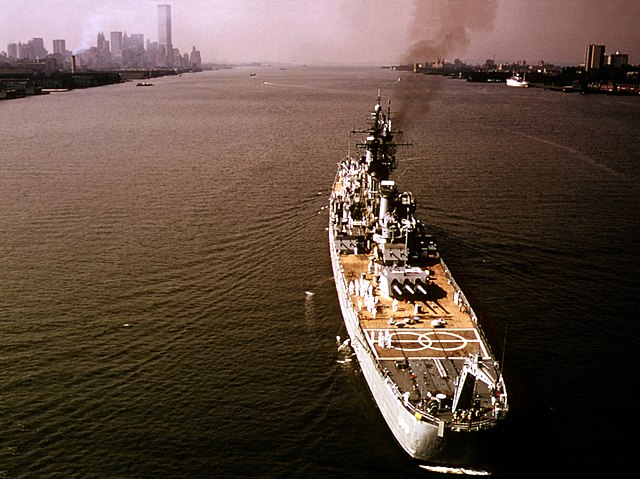
USS Newport News back in the Hudson River, New York, 1974, honoring her Vietnam service. The press commended her as the The “Gray Ghost from the East Coast”
She had a full examination at Subic Bay while the injured were taken car off in various hospitals in the Philippines. She stayed there for several weeks. The damaged gun was removed, the middle gun port plated over. The center gun mount was also to be decommissioned, badly damaged. It was proposed to replace it by one from USS Des Moines or Salem in reserve but the operation was jusged too expensive in a context that saw the end of the war approaching. This was never repaired, the while turret was closed off. She became in practice a two-turrets, six guns cruisers.
Her service in Vietnam was estimated over when she served again briefly from late October to December 1972, and proceeded to Norfolk. 1973-1974 saw training cruises, ports visits until it was estimated time for her decommission given her general state. The naval board considered her unique capability in the fleet and she was the subject in 1975 of a survey unlike her sisters to determine what to do between an economical refitting and full modernization.
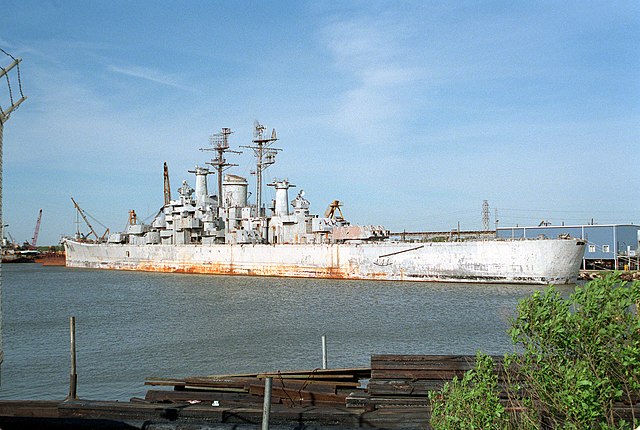
Newport News in New Orleans, 1993, just before being scrapped
USS Newport News was eventually decommissioned on 27 June 1975, almost 15 years after her sisters. The Carter Administration has her stricken on 31 July 1978 and she retired at the Philadelphia Naval Shipyard’s Mothball for an additional decade. In 1981, she was subjected by the same study that her sisters under the Reagan administration and the “500 ship program”. However due to her general state being worst than her sisters, she fell out of consideration rather quickly. She was sold in New Orleans for scrapping on 25 February 1993 (Clinton Administration). There was a proposal to turn her as a museum ship, but since her class was already represented by the presrrved USS Salem, she was scrapped, leaving only her bell and other items, hosted in Salem.
Read More
Books
Andrews, George A., LCDR (March 2022). “Navy Department, Bureau of Ships, Design Branch, CA-139 Class Design History, 31 March 1945”. Warship International. LIX (1)
Friedman, Norman (1980). “United States of America”. In Chesneau, Roger (ed.). Conway’s All the World’s Fighting Ships 1922–1946. New York: Mayflower Books.
J. Gardiner, Conway’s all the world’s fighting ships 1947-95.
Links
usni.org armaments-innovations-last-8-inch-cruiser-guns
jstor.org/ The Eight-Inch Gun Cruiser W. D. PULESTON
on ibiblio.org/
on en.wikipedia.org/
on navsource.org/
on navy-matters.blogspot.com/
on world-war.co.uk/
on navypedia.org/
on navysite.de/
moderniation proposals on quora.com/
on uss-salem.org/
hnsa.org/
globalsecurity.org/
navsource.org/
on history.navy.mil/
on www.hauntedship.com/
http://www.uss-newport-news.com
on nytimes.com 1972/
usni.org/ proceedings 2012 fire-turret-two
unm.edu T2_Investigation_Summary
navweaps.com 8-55_mk16.php
navweaps.com/ 3-50_mk10-22.php
on nvr.navy.mil
on dvidshub.net
ussnewportnewsstore.org/
uss-newport-news.com/
Video
Gun barrel of a DesMoines class (here USS Salem)
Model Kits

On sdmodelmakers.com
Blue Ridge Models 1:700 on scalemates. The 1:350 also was covered by this brand
The subject has been covered also by Very Fire at 1:350
Combrig and Commander Series Models covered the 1:700 as well. The most impressive remains the The Scale Shipyard 1:96. Full query on scalemates.
3D
https://warthunder.com/en/news/7991-development-winter-event-uss-newport-news-ca-148-en


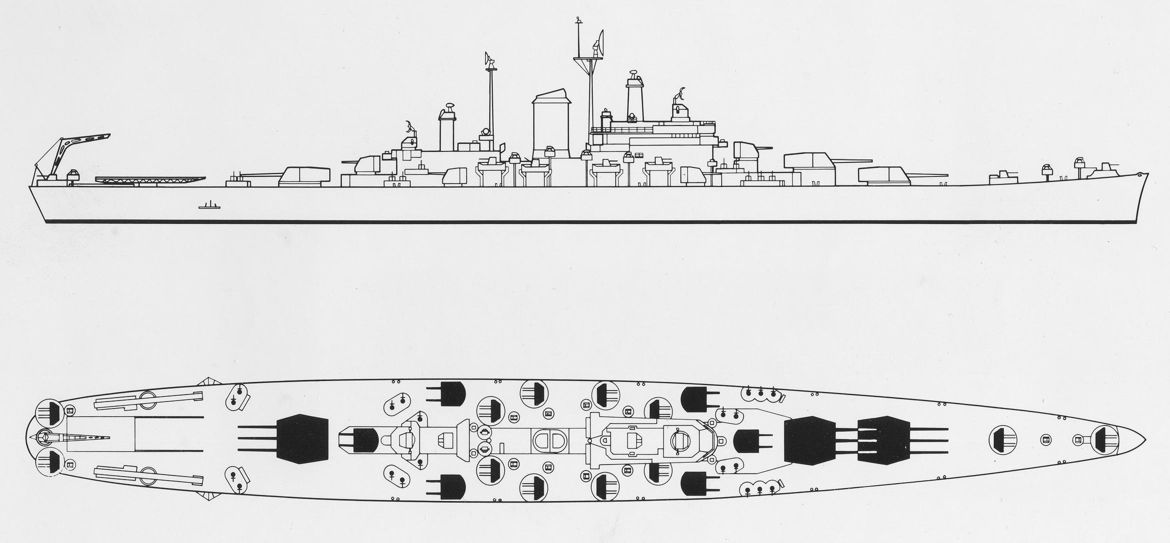
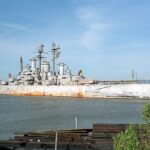
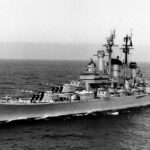
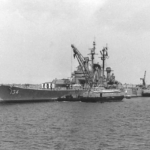
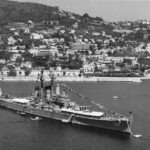
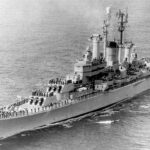
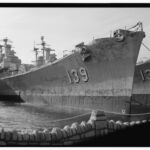
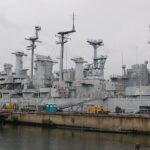
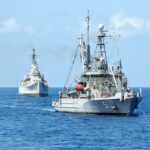
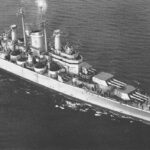
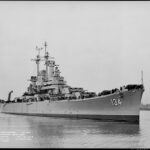
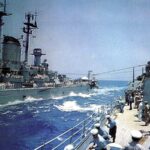
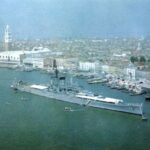
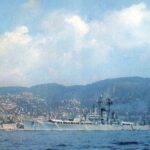
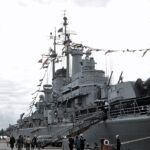
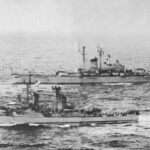
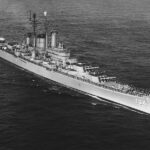
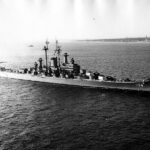
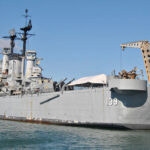
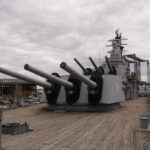
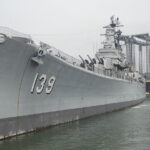
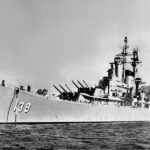
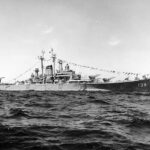
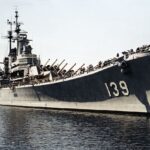
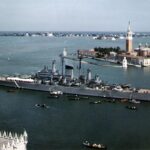
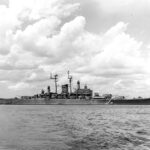
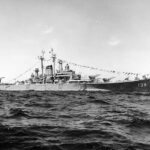
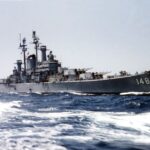
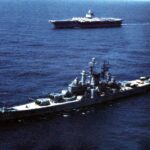
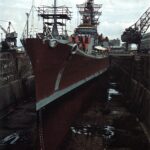
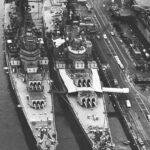
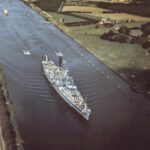
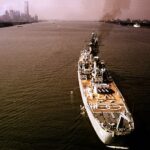
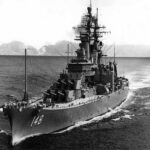
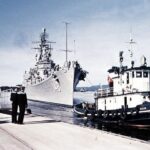
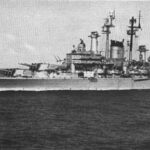
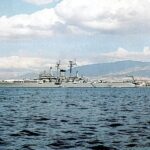
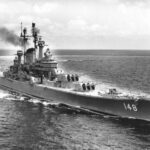
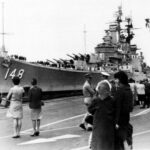
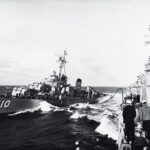
 Latest Facebook Entry -
Latest Facebook Entry -  X(Tweeter) Naval Encyclopedia's deck archive
X(Tweeter) Naval Encyclopedia's deck archive Instagram (@navalencyc)
Instagram (@navalencyc)





 Austrian Navy
Austrian Navy French Navy
French Navy Royal Navy
Royal Navy Armada Espanola
Armada Espanola K.u.K. Kriegsmarine
K.u.K. Kriegsmarine Dansk Marine
Dansk Marine Nautiko Hellenon
Nautiko Hellenon Koninklije Marine 1870
Koninklije Marine 1870 Marinha do Brasil
Marinha do Brasil Osmanlı Donanması
Osmanlı Donanması Marina Do Peru
Marina Do Peru Marinha do Portugal
Marinha do Portugal Regia Marina 1870
Regia Marina 1870 Nihhon Kaigun 1870
Nihhon Kaigun 1870 Preußische Marine 1870
Preußische Marine 1870 Russkiy Flot 1870
Russkiy Flot 1870 Svenska marinen
Svenska marinen Søværnet
Søværnet Union Navy
Union Navy Confederate Navy
Confederate Navy Armada de Argentina
Armada de Argentina Imperial Chinese Navy
Imperial Chinese Navy Marinha do Portugal
Marinha do Portugal Mexico
Mexico Kaiserliche Marine
Kaiserliche Marine 1898 US Navy
1898 US Navy Russkiy Flot
Russkiy Flot French Naval Aviation
French Naval Aviation Russian Naval Aviation
Russian Naval Aviation Sovietskiy Flot
Sovietskiy Flot Royal Canadian Navy
Royal Canadian Navy Royal Australian Navy
Royal Australian Navy RNZN Fleet
RNZN Fleet Chinese Navy 1937
Chinese Navy 1937 Kriegsmarine
Kriegsmarine Chilean Navy
Chilean Navy Danish Navy
Danish Navy Finnish Navy
Finnish Navy Hellenic Navy
Hellenic Navy Polish Navy
Polish Navy Romanian Navy
Romanian Navy Turkish Navy
Turkish Navy Royal Yugoslav Navy
Royal Yugoslav Navy Royal Thai Navy
Royal Thai Navy Minor Navies
Minor Navies Albania
Albania Austria
Austria Belgium
Belgium Columbia
Columbia Costa Rica
Costa Rica Cuba
Cuba Czechoslovakia
Czechoslovakia Dominican Republic
Dominican Republic Haiti
Haiti Hungary
Hungary Honduras
Honduras Estonia
Estonia Iceland
Iceland Eire
Eire Equador
Equador Iran
Iran Iraq
Iraq Latvia
Latvia Liberia
Liberia Lithuania
Lithuania Mandchukuo
Mandchukuo Morocco
Morocco Nicaragua
Nicaragua Persia
Persia San Salvador
San Salvador Sarawak
Sarawak Uruguay
Uruguay Venezuela
Venezuela Zanzibar
Zanzibar Warsaw Pact Navies
Warsaw Pact Navies Bulgaria
Bulgaria Hungary
Hungary

 Bundesmarine
Bundesmarine Dutch Navy
Dutch Navy Hellenic Navy
Hellenic Navy Marina Militare
Marina Militare Taiwanese Navy
Taiwanese Navy Chinese Navy
Chinese Navy Indian Navy
Indian Navy Indonesian Navy
Indonesian Navy JMSDF
JMSDF North Korean Navy
North Korean Navy Philippines Navy
Philippines Navy ROKN
ROKN IDF Navy
IDF Navy Royal New Zealand Navy
Royal New Zealand Navy Egyptian Navy
Egyptian Navy South African Navy
South African Navy

































 RN
RN
 Marine Nationale
Marine Nationale
 Soviet Navy
Soviet Navy
 dbodesign
dbodesign